Brand Management
VerifiedAdded on 2023/03/20
|24
|5312
|45
AI Summary
This report discusses the importance of brand management in marketing and explores the case study of Bega Cheese in Australia. It covers topics such as brand positioning, differentiation, and strategic planning. The report also highlights the challenges faced by the brand and provides recommendations for improvement.
Contribute Materials
Your contribution can guide someone’s learning journey. Share your
documents today.
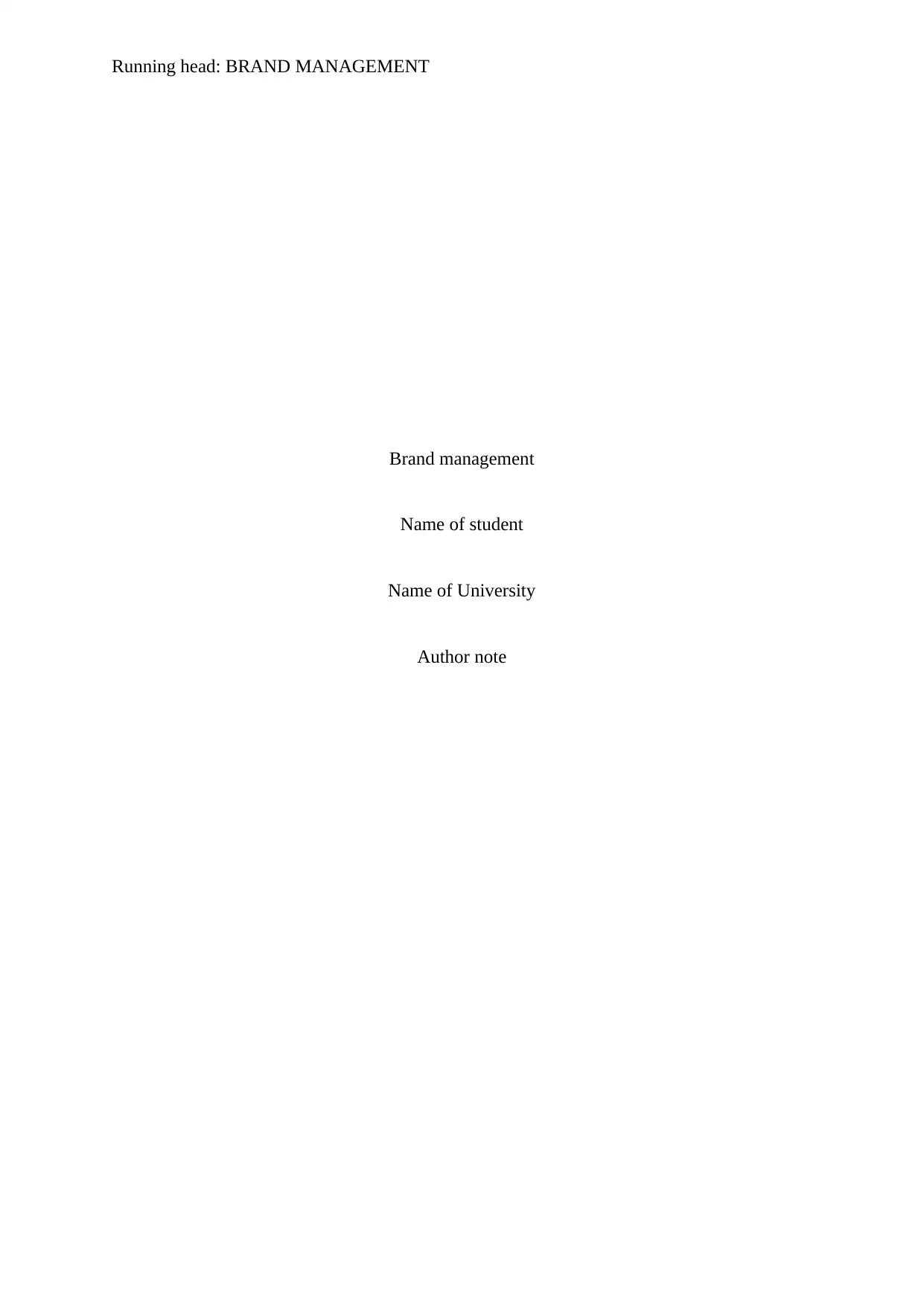
Running head: BRAND MANAGEMENT
Brand management
Name of student
Name of University
Author note
Brand management
Name of student
Name of University
Author note
Secure Best Marks with AI Grader
Need help grading? Try our AI Grader for instant feedback on your assignments.
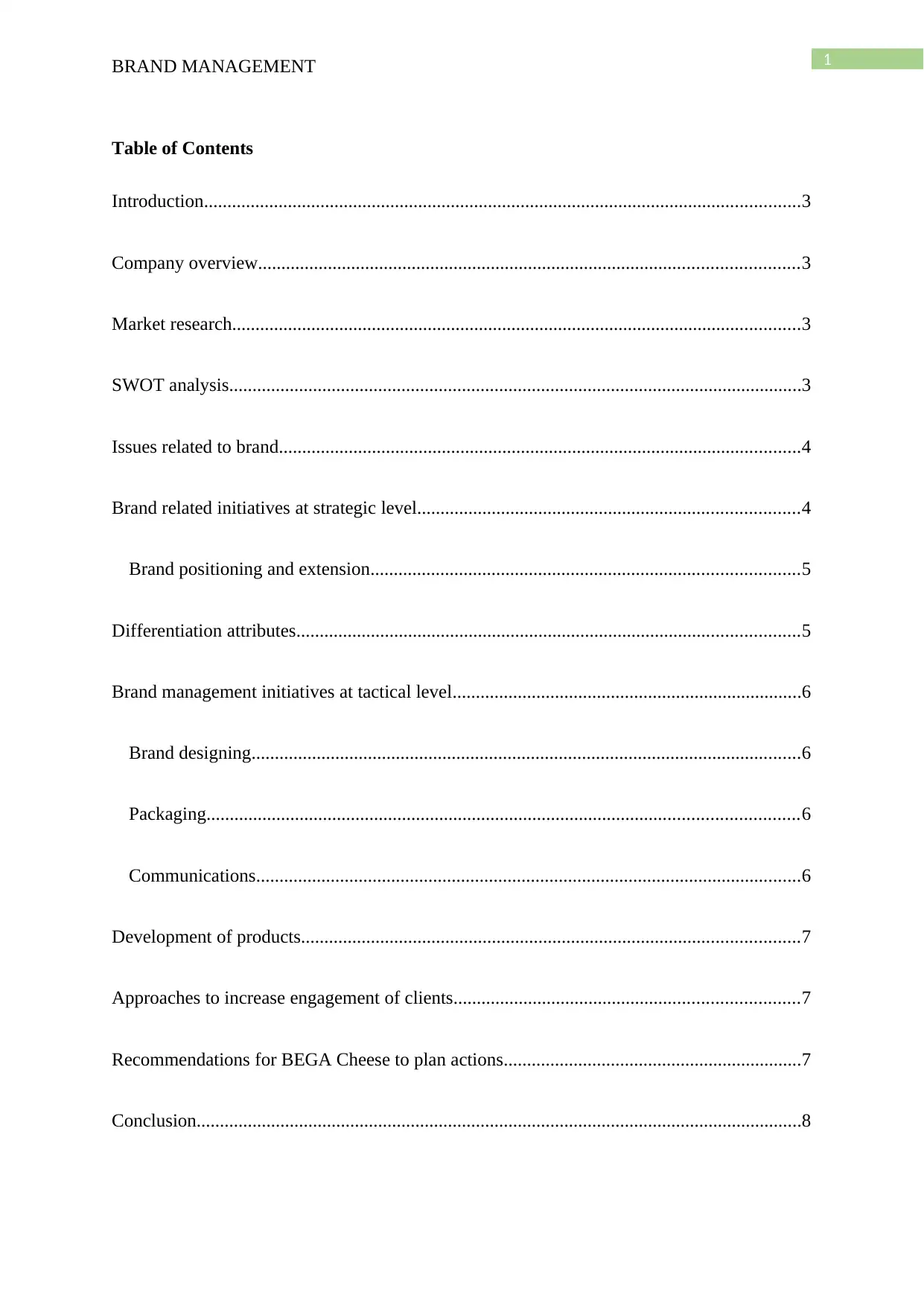
1BRAND MANAGEMENT
Table of Contents
Introduction................................................................................................................................3
Company overview....................................................................................................................3
Market research..........................................................................................................................3
SWOT analysis...........................................................................................................................3
Issues related to brand................................................................................................................4
Brand related initiatives at strategic level..................................................................................4
Brand positioning and extension............................................................................................5
Differentiation attributes............................................................................................................5
Brand management initiatives at tactical level...........................................................................6
Brand designing......................................................................................................................6
Packaging...............................................................................................................................6
Communications.....................................................................................................................6
Development of products...........................................................................................................7
Approaches to increase engagement of clients..........................................................................7
Recommendations for BEGA Cheese to plan actions................................................................7
Conclusion..................................................................................................................................8
Table of Contents
Introduction................................................................................................................................3
Company overview....................................................................................................................3
Market research..........................................................................................................................3
SWOT analysis...........................................................................................................................3
Issues related to brand................................................................................................................4
Brand related initiatives at strategic level..................................................................................4
Brand positioning and extension............................................................................................5
Differentiation attributes............................................................................................................5
Brand management initiatives at tactical level...........................................................................6
Brand designing......................................................................................................................6
Packaging...............................................................................................................................6
Communications.....................................................................................................................6
Development of products...........................................................................................................7
Approaches to increase engagement of clients..........................................................................7
Recommendations for BEGA Cheese to plan actions................................................................7
Conclusion..................................................................................................................................8
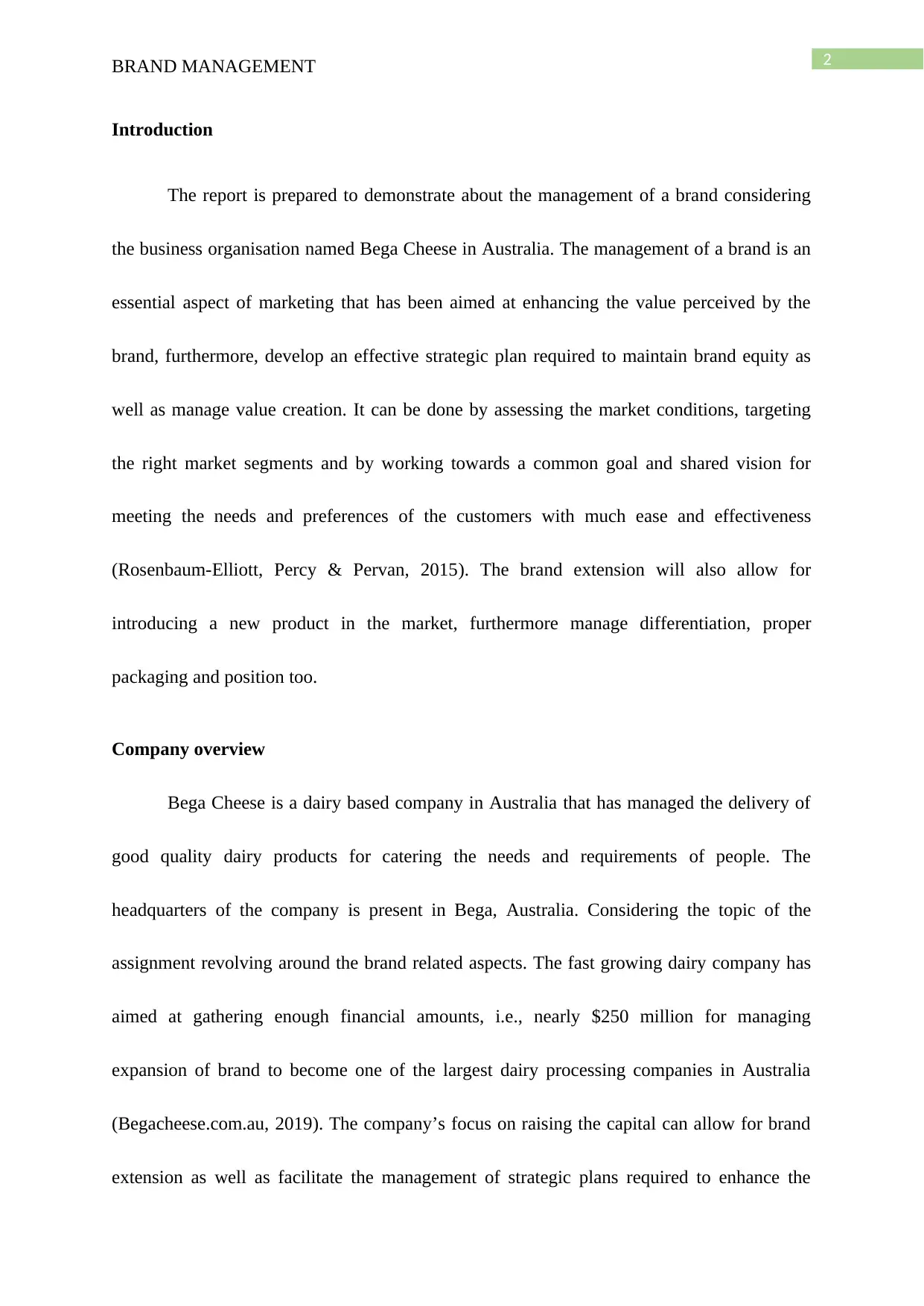
2BRAND MANAGEMENT
Introduction
The report is prepared to demonstrate about the management of a brand considering
the business organisation named Bega Cheese in Australia. The management of a brand is an
essential aspect of marketing that has been aimed at enhancing the value perceived by the
brand, furthermore, develop an effective strategic plan required to maintain brand equity as
well as manage value creation. It can be done by assessing the market conditions, targeting
the right market segments and by working towards a common goal and shared vision for
meeting the needs and preferences of the customers with much ease and effectiveness
(Rosenbaum-Elliott, Percy & Pervan, 2015). The brand extension will also allow for
introducing a new product in the market, furthermore manage differentiation, proper
packaging and position too.
Company overview
Bega Cheese is a dairy based company in Australia that has managed the delivery of
good quality dairy products for catering the needs and requirements of people. The
headquarters of the company is present in Bega, Australia. Considering the topic of the
assignment revolving around the brand related aspects. The fast growing dairy company has
aimed at gathering enough financial amounts, i.e., nearly $250 million for managing
expansion of brand to become one of the largest dairy processing companies in Australia
(Begacheese.com.au, 2019). The company’s focus on raising the capital can allow for brand
extension as well as facilitate the management of strategic plans required to enhance the
Introduction
The report is prepared to demonstrate about the management of a brand considering
the business organisation named Bega Cheese in Australia. The management of a brand is an
essential aspect of marketing that has been aimed at enhancing the value perceived by the
brand, furthermore, develop an effective strategic plan required to maintain brand equity as
well as manage value creation. It can be done by assessing the market conditions, targeting
the right market segments and by working towards a common goal and shared vision for
meeting the needs and preferences of the customers with much ease and effectiveness
(Rosenbaum-Elliott, Percy & Pervan, 2015). The brand extension will also allow for
introducing a new product in the market, furthermore manage differentiation, proper
packaging and position too.
Company overview
Bega Cheese is a dairy based company in Australia that has managed the delivery of
good quality dairy products for catering the needs and requirements of people. The
headquarters of the company is present in Bega, Australia. Considering the topic of the
assignment revolving around the brand related aspects. The fast growing dairy company has
aimed at gathering enough financial amounts, i.e., nearly $250 million for managing
expansion of brand to become one of the largest dairy processing companies in Australia
(Begacheese.com.au, 2019). The company’s focus on raising the capital can allow for brand
extension as well as facilitate the management of strategic plans required to enhance the
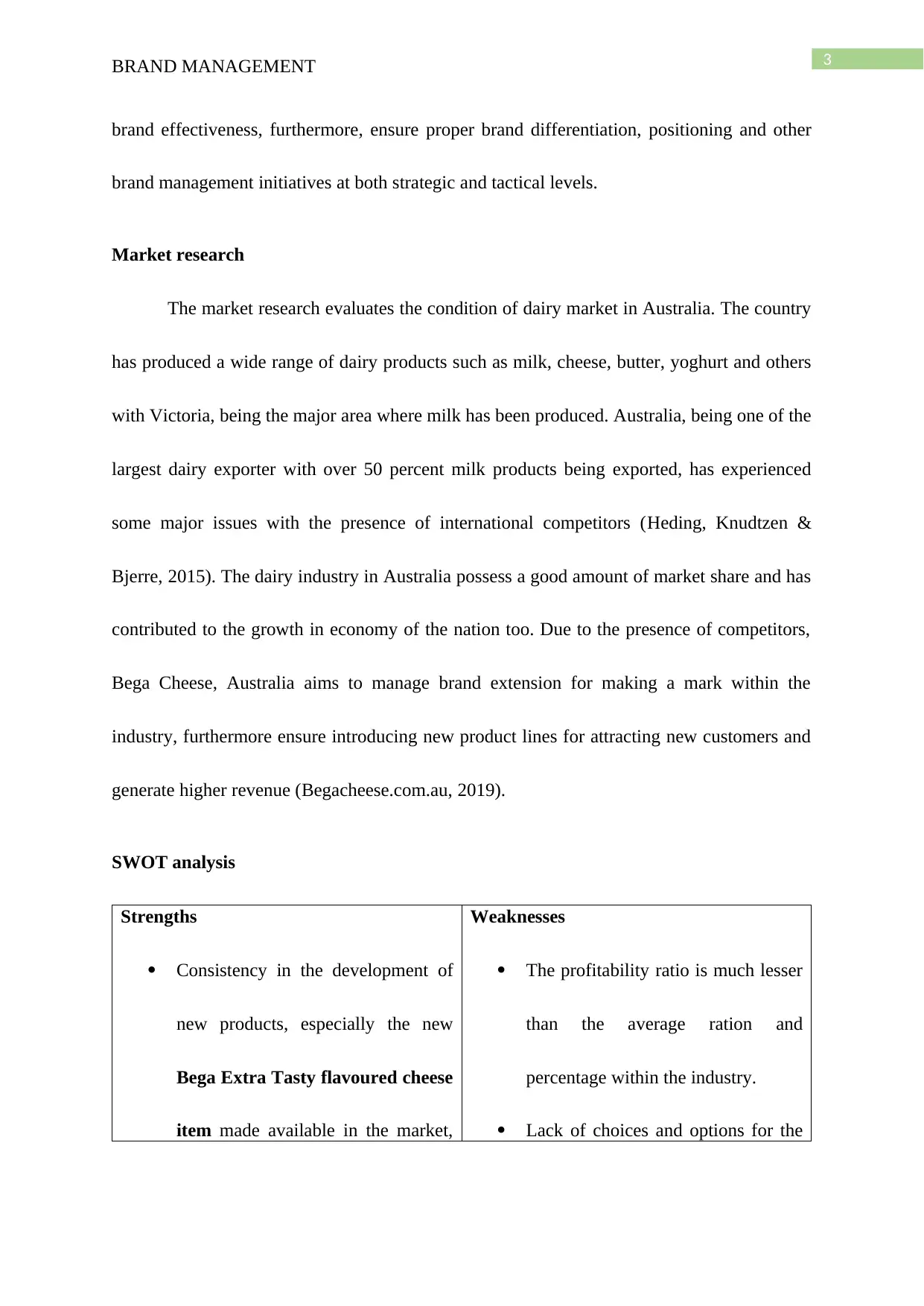
3BRAND MANAGEMENT
brand effectiveness, furthermore, ensure proper brand differentiation, positioning and other
brand management initiatives at both strategic and tactical levels.
Market research
The market research evaluates the condition of dairy market in Australia. The country
has produced a wide range of dairy products such as milk, cheese, butter, yoghurt and others
with Victoria, being the major area where milk has been produced. Australia, being one of the
largest dairy exporter with over 50 percent milk products being exported, has experienced
some major issues with the presence of international competitors (Heding, Knudtzen &
Bjerre, 2015). The dairy industry in Australia possess a good amount of market share and has
contributed to the growth in economy of the nation too. Due to the presence of competitors,
Bega Cheese, Australia aims to manage brand extension for making a mark within the
industry, furthermore ensure introducing new product lines for attracting new customers and
generate higher revenue (Begacheese.com.au, 2019).
SWOT analysis
Strengths
Consistency in the development of
new products, especially the new
Bega Extra Tasty flavoured cheese
item made available in the market,
Weaknesses
The profitability ratio is much lesser
than the average ration and
percentage within the industry.
Lack of choices and options for the
brand effectiveness, furthermore, ensure proper brand differentiation, positioning and other
brand management initiatives at both strategic and tactical levels.
Market research
The market research evaluates the condition of dairy market in Australia. The country
has produced a wide range of dairy products such as milk, cheese, butter, yoghurt and others
with Victoria, being the major area where milk has been produced. Australia, being one of the
largest dairy exporter with over 50 percent milk products being exported, has experienced
some major issues with the presence of international competitors (Heding, Knudtzen &
Bjerre, 2015). The dairy industry in Australia possess a good amount of market share and has
contributed to the growth in economy of the nation too. Due to the presence of competitors,
Bega Cheese, Australia aims to manage brand extension for making a mark within the
industry, furthermore ensure introducing new product lines for attracting new customers and
generate higher revenue (Begacheese.com.au, 2019).
SWOT analysis
Strengths
Consistency in the development of
new products, especially the new
Bega Extra Tasty flavoured cheese
item made available in the market,
Weaknesses
The profitability ratio is much lesser
than the average ration and
percentage within the industry.
Lack of choices and options for the
Secure Best Marks with AI Grader
Need help grading? Try our AI Grader for instant feedback on your assignments.
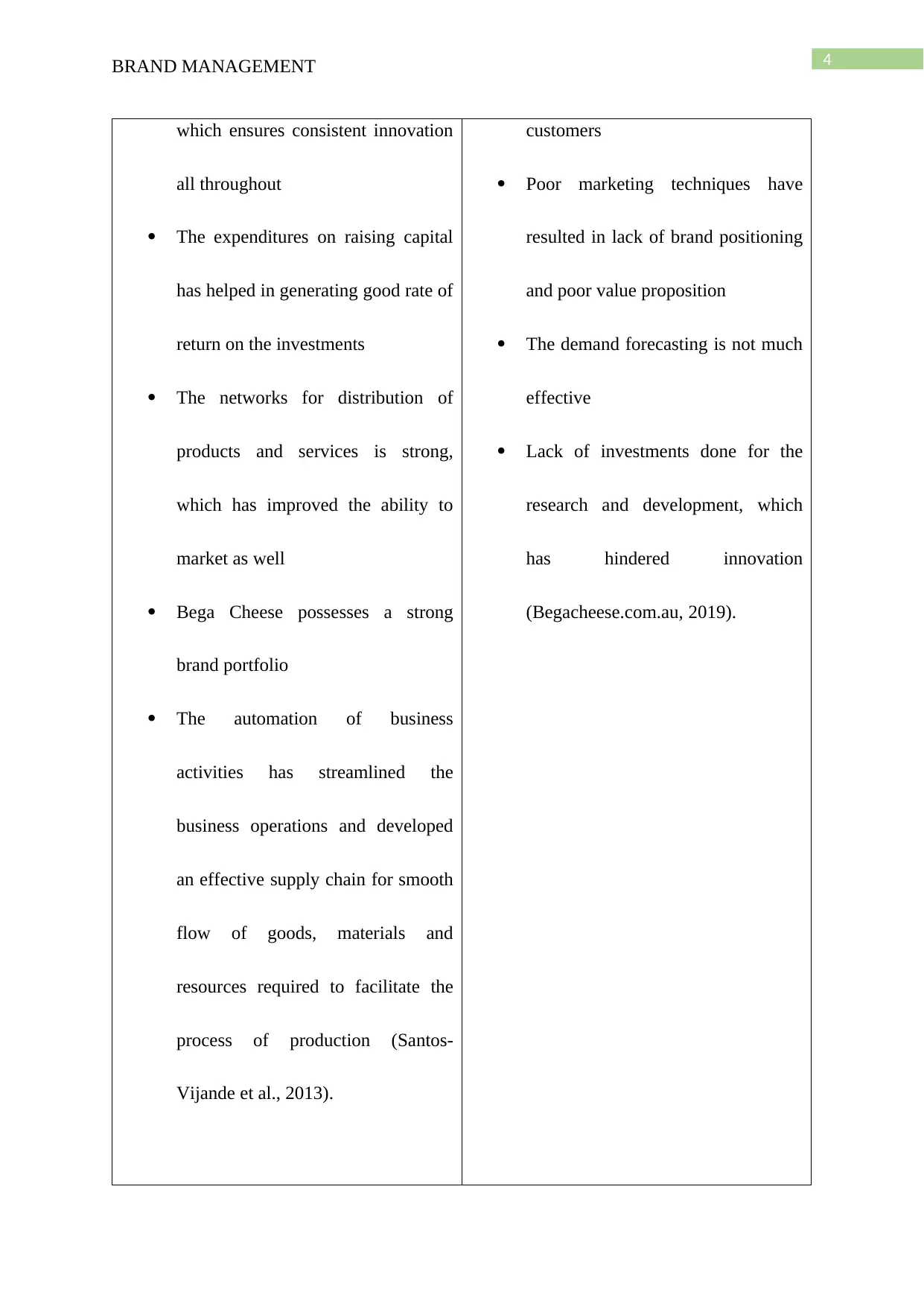
4BRAND MANAGEMENT
which ensures consistent innovation
all throughout
The expenditures on raising capital
has helped in generating good rate of
return on the investments
The networks for distribution of
products and services is strong,
which has improved the ability to
market as well
Bega Cheese possesses a strong
brand portfolio
The automation of business
activities has streamlined the
business operations and developed
an effective supply chain for smooth
flow of goods, materials and
resources required to facilitate the
process of production (Santos-
Vijande et al., 2013).
customers
Poor marketing techniques have
resulted in lack of brand positioning
and poor value proposition
The demand forecasting is not much
effective
Lack of investments done for the
research and development, which
has hindered innovation
(Begacheese.com.au, 2019).
which ensures consistent innovation
all throughout
The expenditures on raising capital
has helped in generating good rate of
return on the investments
The networks for distribution of
products and services is strong,
which has improved the ability to
market as well
Bega Cheese possesses a strong
brand portfolio
The automation of business
activities has streamlined the
business operations and developed
an effective supply chain for smooth
flow of goods, materials and
resources required to facilitate the
process of production (Santos-
Vijande et al., 2013).
customers
Poor marketing techniques have
resulted in lack of brand positioning
and poor value proposition
The demand forecasting is not much
effective
Lack of investments done for the
research and development, which
has hindered innovation
(Begacheese.com.au, 2019).
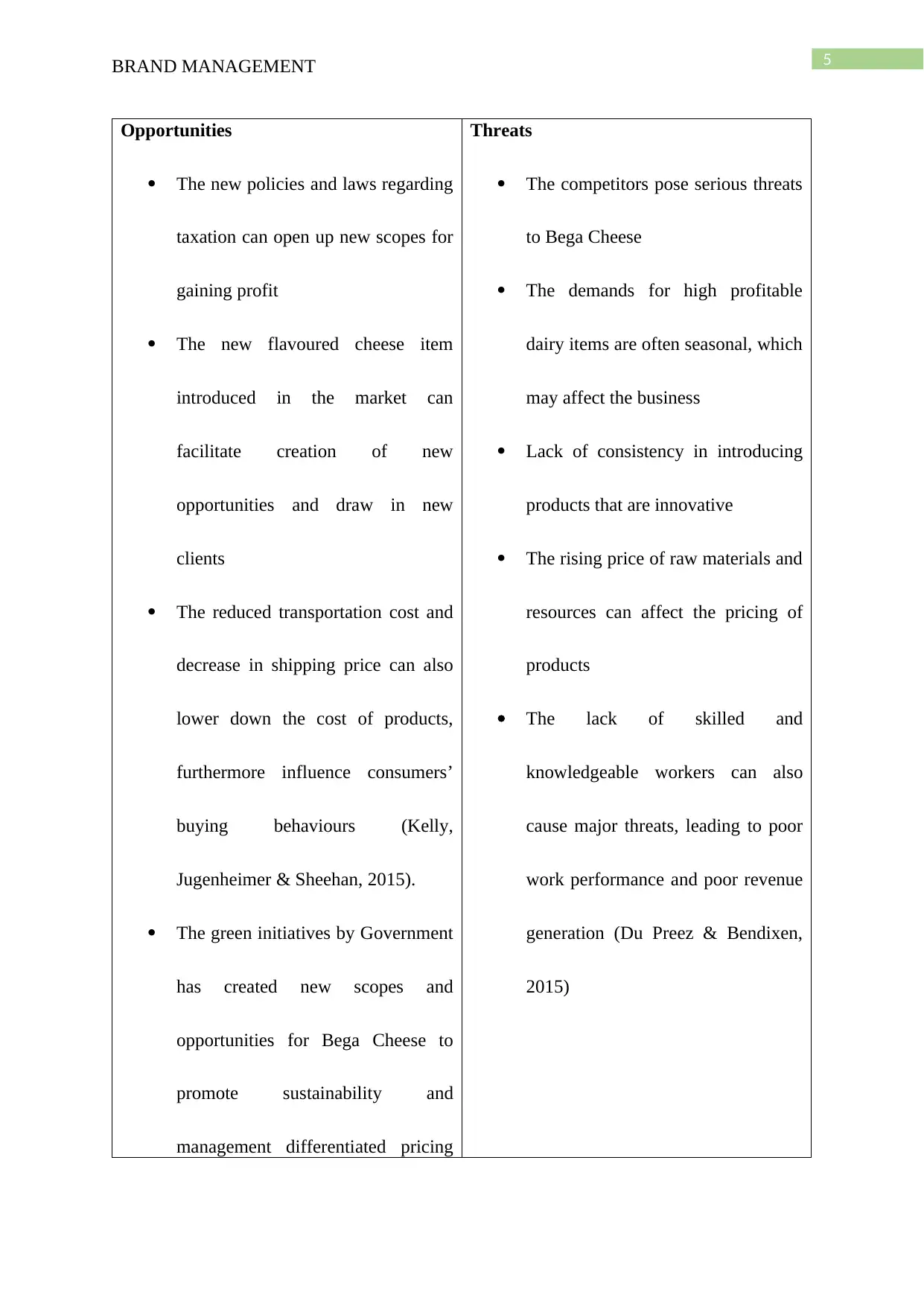
5BRAND MANAGEMENT
Opportunities
The new policies and laws regarding
taxation can open up new scopes for
gaining profit
The new flavoured cheese item
introduced in the market can
facilitate creation of new
opportunities and draw in new
clients
The reduced transportation cost and
decrease in shipping price can also
lower down the cost of products,
furthermore influence consumers’
buying behaviours (Kelly,
Jugenheimer & Sheehan, 2015).
The green initiatives by Government
has created new scopes and
opportunities for Bega Cheese to
promote sustainability and
management differentiated pricing
Threats
The competitors pose serious threats
to Bega Cheese
The demands for high profitable
dairy items are often seasonal, which
may affect the business
Lack of consistency in introducing
products that are innovative
The rising price of raw materials and
resources can affect the pricing of
products
The lack of skilled and
knowledgeable workers can also
cause major threats, leading to poor
work performance and poor revenue
generation (Du Preez & Bendixen,
2015)
Opportunities
The new policies and laws regarding
taxation can open up new scopes for
gaining profit
The new flavoured cheese item
introduced in the market can
facilitate creation of new
opportunities and draw in new
clients
The reduced transportation cost and
decrease in shipping price can also
lower down the cost of products,
furthermore influence consumers’
buying behaviours (Kelly,
Jugenheimer & Sheehan, 2015).
The green initiatives by Government
has created new scopes and
opportunities for Bega Cheese to
promote sustainability and
management differentiated pricing
Threats
The competitors pose serious threats
to Bega Cheese
The demands for high profitable
dairy items are often seasonal, which
may affect the business
Lack of consistency in introducing
products that are innovative
The rising price of raw materials and
resources can affect the pricing of
products
The lack of skilled and
knowledgeable workers can also
cause major threats, leading to poor
work performance and poor revenue
generation (Du Preez & Bendixen,
2015)
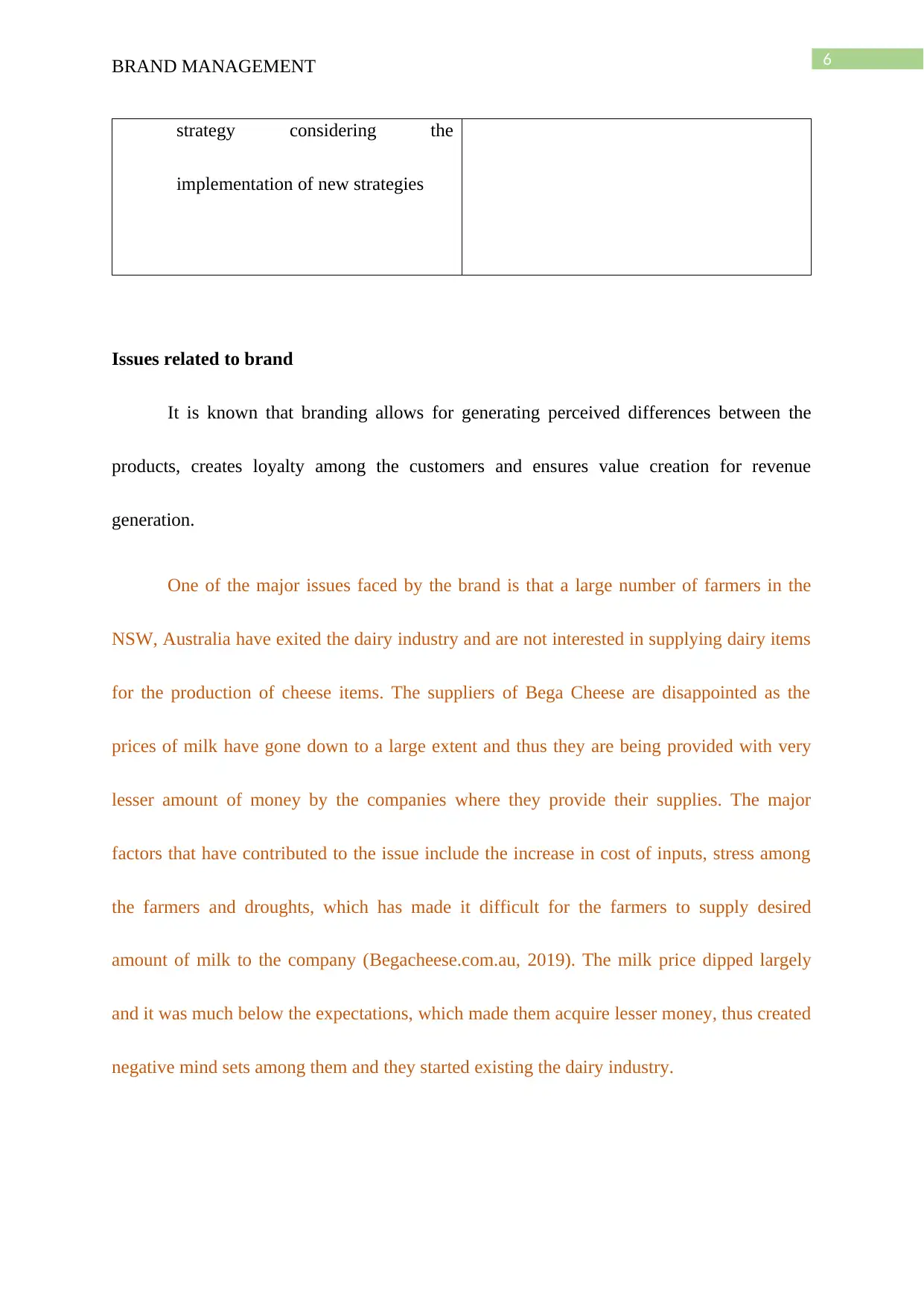
6BRAND MANAGEMENT
strategy considering the
implementation of new strategies
Issues related to brand
It is known that branding allows for generating perceived differences between the
products, creates loyalty among the customers and ensures value creation for revenue
generation.
One of the major issues faced by the brand is that a large number of farmers in the
NSW, Australia have exited the dairy industry and are not interested in supplying dairy items
for the production of cheese items. The suppliers of Bega Cheese are disappointed as the
prices of milk have gone down to a large extent and thus they are being provided with very
lesser amount of money by the companies where they provide their supplies. The major
factors that have contributed to the issue include the increase in cost of inputs, stress among
the farmers and droughts, which has made it difficult for the farmers to supply desired
amount of milk to the company (Begacheese.com.au, 2019). The milk price dipped largely
and it was much below the expectations, which made them acquire lesser money, thus created
negative mind sets among them and they started existing the dairy industry.
strategy considering the
implementation of new strategies
Issues related to brand
It is known that branding allows for generating perceived differences between the
products, creates loyalty among the customers and ensures value creation for revenue
generation.
One of the major issues faced by the brand is that a large number of farmers in the
NSW, Australia have exited the dairy industry and are not interested in supplying dairy items
for the production of cheese items. The suppliers of Bega Cheese are disappointed as the
prices of milk have gone down to a large extent and thus they are being provided with very
lesser amount of money by the companies where they provide their supplies. The major
factors that have contributed to the issue include the increase in cost of inputs, stress among
the farmers and droughts, which has made it difficult for the farmers to supply desired
amount of milk to the company (Begacheese.com.au, 2019). The milk price dipped largely
and it was much below the expectations, which made them acquire lesser money, thus created
negative mind sets among them and they started existing the dairy industry.
Paraphrase This Document
Need a fresh take? Get an instant paraphrase of this document with our AI Paraphraser

7BRAND MANAGEMENT
The cheese category within the Australian dairy industry continued to change and thus
the pressure had been immense at the value end, because of which, most of the brands in New
Zealand and Tasmania made sure to maintain a premium status with the consideration of its
origin. A new opportunity has been created for Bega Cheese to reposition the brand and keep
up pace with the changing demands of customers, which had been another major brand
related issue. The tagline of Bega Cheese was “Real town, real cheese”, which made the
brand deliver its promises by communicating with the farmers and providing them with
necessary help and support along with good amount of financial benefits for the supplies they
provided, required to enhance the production (Da Silveira, Lages & Simões, 2013). Due to
this, the company has gained good reputation and the opportunities keep on emerging to
maintain authenticity in terms of business operations and furthermore attain the profitability,
as expected.
According to Zhang (2015), in spite of the benefits, there are other brand related
issues and challenges as well such as the lack of innovation as promised by the brand, poor
understanding of the brand’s consumers and failing to understand their needs and
inappropriate messages and information sharing to the customers due to the poor marketing
techniques (Zhang, 2015). The poor marketing techniques and inability to cope up with the
changing needs and preferences of the customers, which further contributed to the negative
impact on brand equity and affected the trust and loyalty among the customers too regarding
the brand.
The cheese category within the Australian dairy industry continued to change and thus
the pressure had been immense at the value end, because of which, most of the brands in New
Zealand and Tasmania made sure to maintain a premium status with the consideration of its
origin. A new opportunity has been created for Bega Cheese to reposition the brand and keep
up pace with the changing demands of customers, which had been another major brand
related issue. The tagline of Bega Cheese was “Real town, real cheese”, which made the
brand deliver its promises by communicating with the farmers and providing them with
necessary help and support along with good amount of financial benefits for the supplies they
provided, required to enhance the production (Da Silveira, Lages & Simões, 2013). Due to
this, the company has gained good reputation and the opportunities keep on emerging to
maintain authenticity in terms of business operations and furthermore attain the profitability,
as expected.
According to Zhang (2015), in spite of the benefits, there are other brand related
issues and challenges as well such as the lack of innovation as promised by the brand, poor
understanding of the brand’s consumers and failing to understand their needs and
inappropriate messages and information sharing to the customers due to the poor marketing
techniques (Zhang, 2015). The poor marketing techniques and inability to cope up with the
changing needs and preferences of the customers, which further contributed to the negative
impact on brand equity and affected the trust and loyalty among the customers too regarding
the brand.
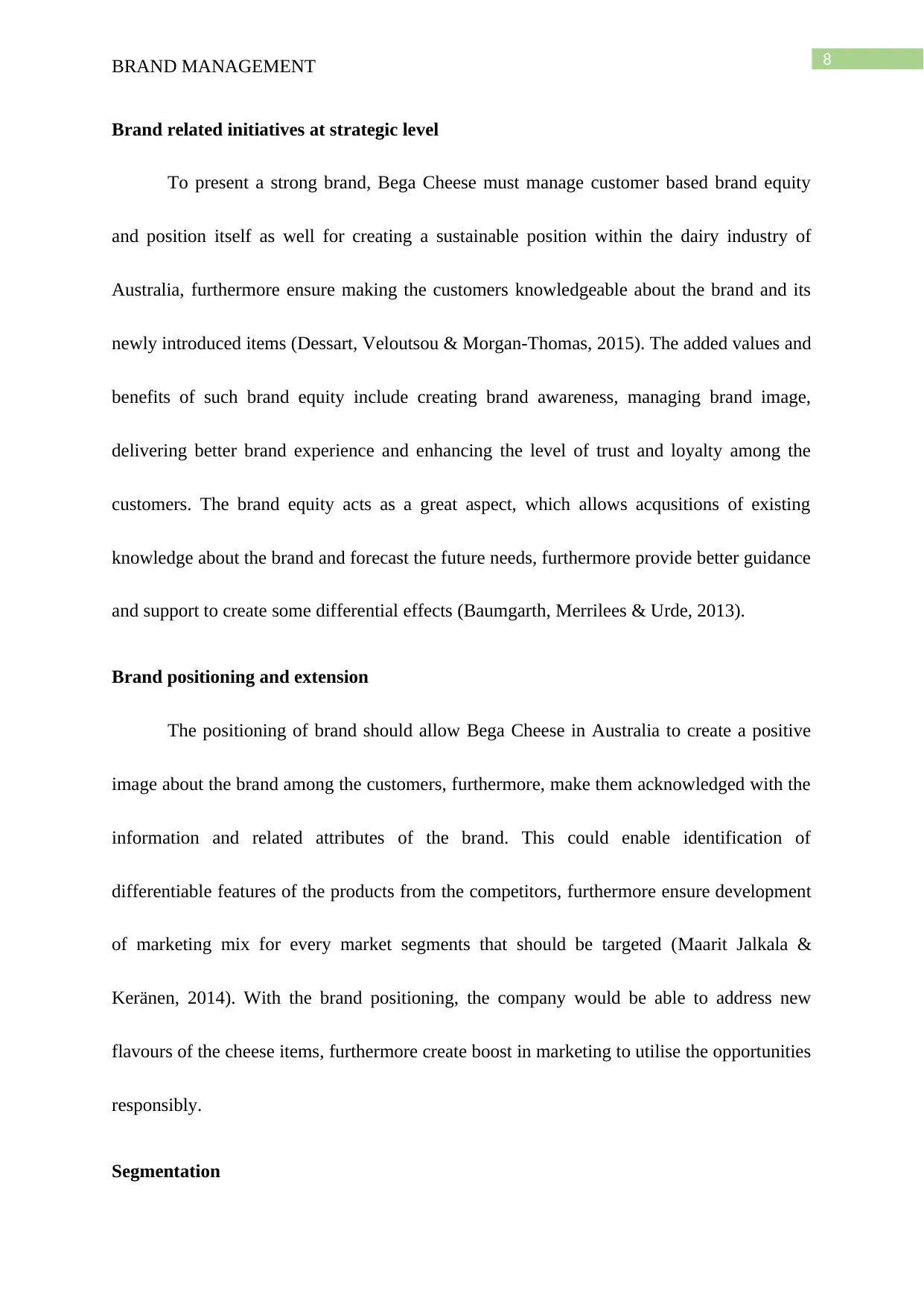
8BRAND MANAGEMENT
Brand related initiatives at strategic level
To present a strong brand, Bega Cheese must manage customer based brand equity
and position itself as well for creating a sustainable position within the dairy industry of
Australia, furthermore ensure making the customers knowledgeable about the brand and its
newly introduced items (Dessart, Veloutsou & Morgan-Thomas, 2015). The added values and
benefits of such brand equity include creating brand awareness, managing brand image,
delivering better brand experience and enhancing the level of trust and loyalty among the
customers. The brand equity acts as a great aspect, which allows acqusitions of existing
knowledge about the brand and forecast the future needs, furthermore provide better guidance
and support to create some differential effects (Baumgarth, Merrilees & Urde, 2013).
Brand positioning and extension
The positioning of brand should allow Bega Cheese in Australia to create a positive
image about the brand among the customers, furthermore, make them acknowledged with the
information and related attributes of the brand. This could enable identification of
differentiable features of the products from the competitors, furthermore ensure development
of marketing mix for every market segments that should be targeted (Maarit Jalkala &
Keränen, 2014). With the brand positioning, the company would be able to address new
flavours of the cheese items, furthermore create boost in marketing to utilise the opportunities
responsibly.
Segmentation
Brand related initiatives at strategic level
To present a strong brand, Bega Cheese must manage customer based brand equity
and position itself as well for creating a sustainable position within the dairy industry of
Australia, furthermore ensure making the customers knowledgeable about the brand and its
newly introduced items (Dessart, Veloutsou & Morgan-Thomas, 2015). The added values and
benefits of such brand equity include creating brand awareness, managing brand image,
delivering better brand experience and enhancing the level of trust and loyalty among the
customers. The brand equity acts as a great aspect, which allows acqusitions of existing
knowledge about the brand and forecast the future needs, furthermore provide better guidance
and support to create some differential effects (Baumgarth, Merrilees & Urde, 2013).
Brand positioning and extension
The positioning of brand should allow Bega Cheese in Australia to create a positive
image about the brand among the customers, furthermore, make them acknowledged with the
information and related attributes of the brand. This could enable identification of
differentiable features of the products from the competitors, furthermore ensure development
of marketing mix for every market segments that should be targeted (Maarit Jalkala &
Keränen, 2014). With the brand positioning, the company would be able to address new
flavours of the cheese items, furthermore create boost in marketing to utilise the opportunities
responsibly.
Segmentation
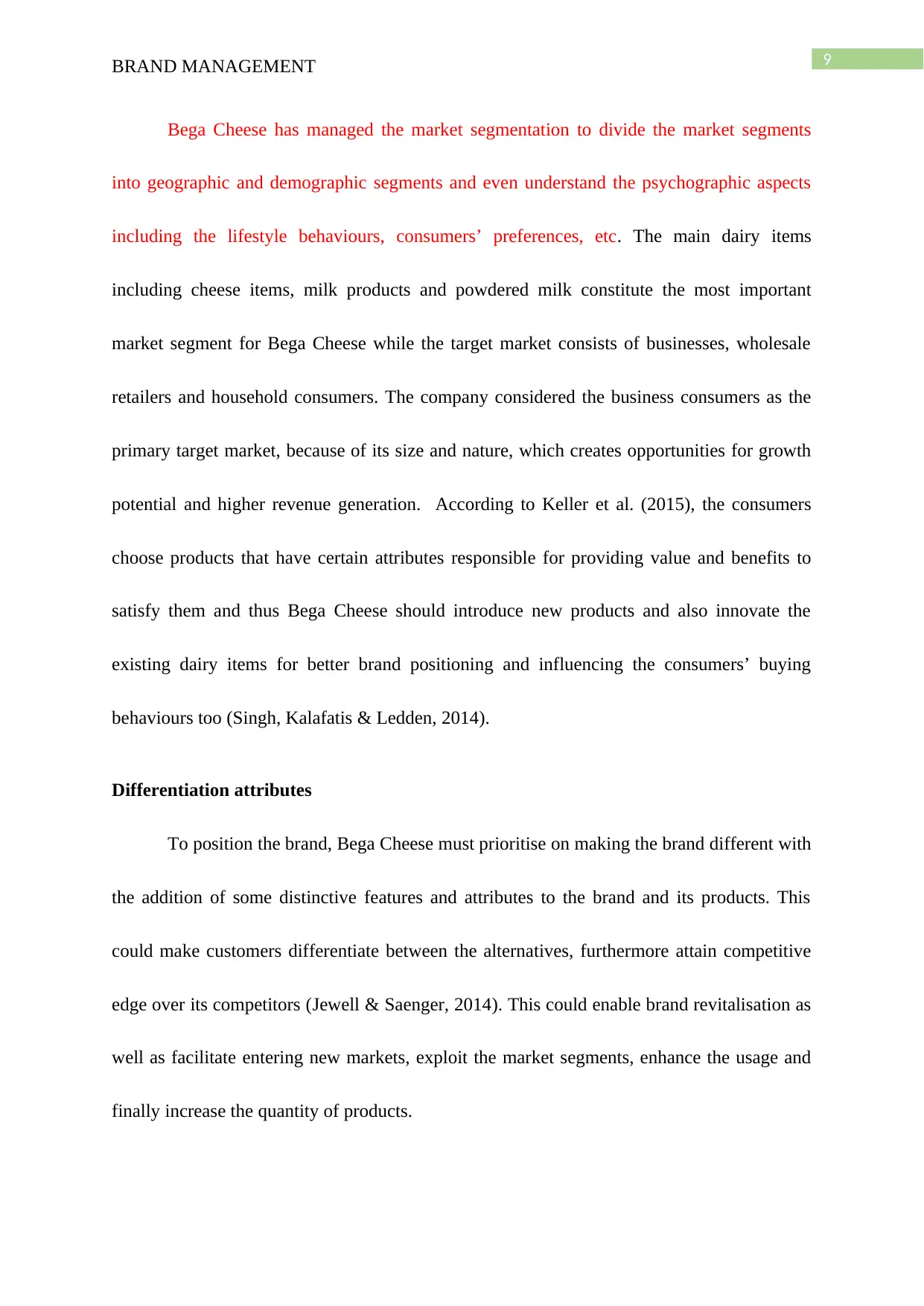
9BRAND MANAGEMENT
Bega Cheese has managed the market segmentation to divide the market segments
into geographic and demographic segments and even understand the psychographic aspects
including the lifestyle behaviours, consumers’ preferences, etc. The main dairy items
including cheese items, milk products and powdered milk constitute the most important
market segment for Bega Cheese while the target market consists of businesses, wholesale
retailers and household consumers. The company considered the business consumers as the
primary target market, because of its size and nature, which creates opportunities for growth
potential and higher revenue generation. According to Keller et al. (2015), the consumers
choose products that have certain attributes responsible for providing value and benefits to
satisfy them and thus Bega Cheese should introduce new products and also innovate the
existing dairy items for better brand positioning and influencing the consumers’ buying
behaviours too (Singh, Kalafatis & Ledden, 2014).
Differentiation attributes
To position the brand, Bega Cheese must prioritise on making the brand different with
the addition of some distinctive features and attributes to the brand and its products. This
could make customers differentiate between the alternatives, furthermore attain competitive
edge over its competitors (Jewell & Saenger, 2014). This could enable brand revitalisation as
well as facilitate entering new markets, exploit the market segments, enhance the usage and
finally increase the quantity of products.
Bega Cheese has managed the market segmentation to divide the market segments
into geographic and demographic segments and even understand the psychographic aspects
including the lifestyle behaviours, consumers’ preferences, etc. The main dairy items
including cheese items, milk products and powdered milk constitute the most important
market segment for Bega Cheese while the target market consists of businesses, wholesale
retailers and household consumers. The company considered the business consumers as the
primary target market, because of its size and nature, which creates opportunities for growth
potential and higher revenue generation. According to Keller et al. (2015), the consumers
choose products that have certain attributes responsible for providing value and benefits to
satisfy them and thus Bega Cheese should introduce new products and also innovate the
existing dairy items for better brand positioning and influencing the consumers’ buying
behaviours too (Singh, Kalafatis & Ledden, 2014).
Differentiation attributes
To position the brand, Bega Cheese must prioritise on making the brand different with
the addition of some distinctive features and attributes to the brand and its products. This
could make customers differentiate between the alternatives, furthermore attain competitive
edge over its competitors (Jewell & Saenger, 2014). This could enable brand revitalisation as
well as facilitate entering new markets, exploit the market segments, enhance the usage and
finally increase the quantity of products.
Secure Best Marks with AI Grader
Need help grading? Try our AI Grader for instant feedback on your assignments.
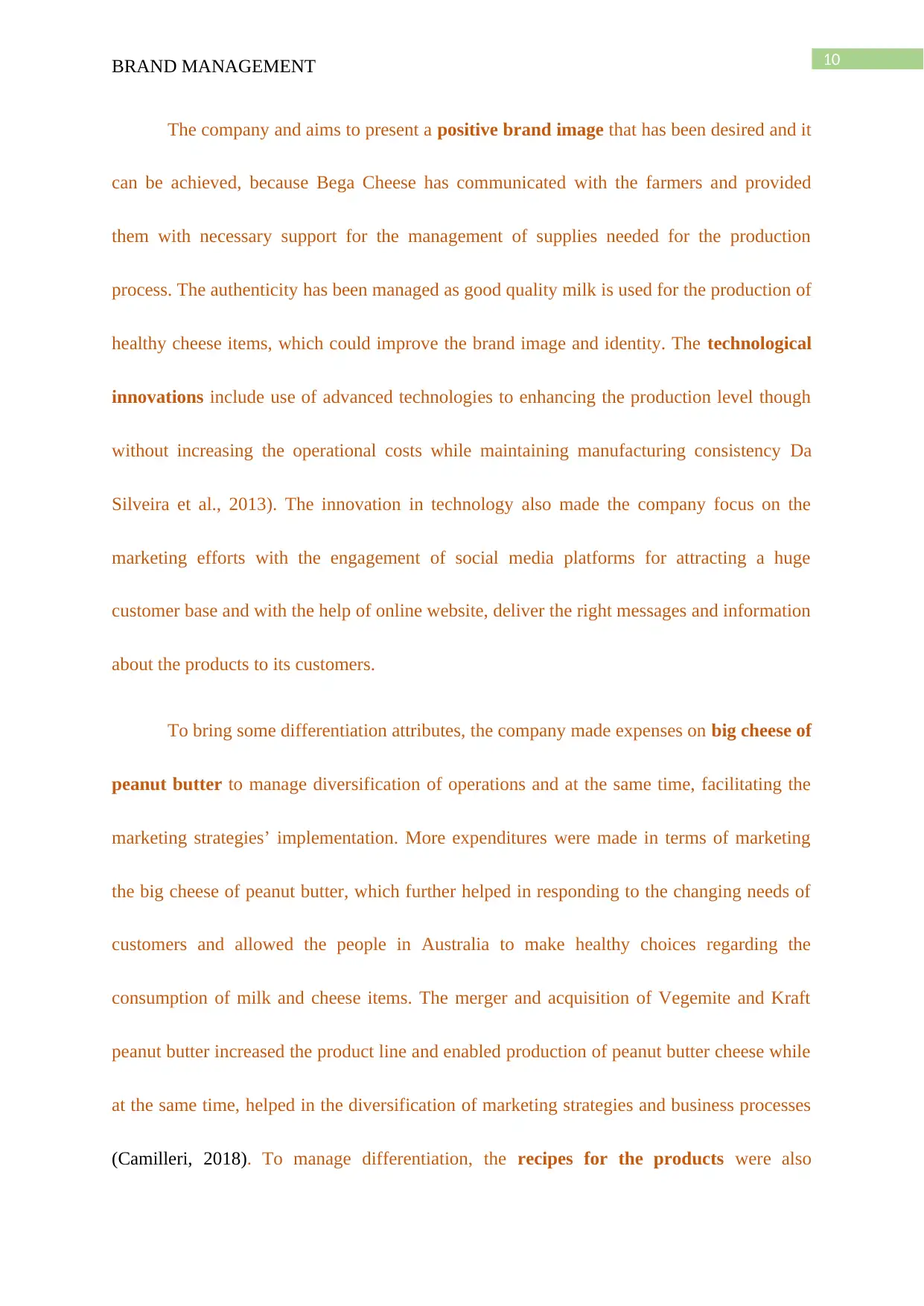
10BRAND MANAGEMENT
The company and aims to present a positive brand image that has been desired and it
can be achieved, because Bega Cheese has communicated with the farmers and provided
them with necessary support for the management of supplies needed for the production
process. The authenticity has been managed as good quality milk is used for the production of
healthy cheese items, which could improve the brand image and identity. The technological
innovations include use of advanced technologies to enhancing the production level though
without increasing the operational costs while maintaining manufacturing consistency Da
Silveira et al., 2013). The innovation in technology also made the company focus on the
marketing efforts with the engagement of social media platforms for attracting a huge
customer base and with the help of online website, deliver the right messages and information
about the products to its customers.
To bring some differentiation attributes, the company made expenses on big cheese of
peanut butter to manage diversification of operations and at the same time, facilitating the
marketing strategies’ implementation. More expenditures were made in terms of marketing
the big cheese of peanut butter, which further helped in responding to the changing needs of
customers and allowed the people in Australia to make healthy choices regarding the
consumption of milk and cheese items. The merger and acquisition of Vegemite and Kraft
peanut butter increased the product line and enabled production of peanut butter cheese while
at the same time, helped in the diversification of marketing strategies and business processes
(Camilleri, 2018). To manage differentiation, the recipes for the products were also
The company and aims to present a positive brand image that has been desired and it
can be achieved, because Bega Cheese has communicated with the farmers and provided
them with necessary support for the management of supplies needed for the production
process. The authenticity has been managed as good quality milk is used for the production of
healthy cheese items, which could improve the brand image and identity. The technological
innovations include use of advanced technologies to enhancing the production level though
without increasing the operational costs while maintaining manufacturing consistency Da
Silveira et al., 2013). The innovation in technology also made the company focus on the
marketing efforts with the engagement of social media platforms for attracting a huge
customer base and with the help of online website, deliver the right messages and information
about the products to its customers.
To bring some differentiation attributes, the company made expenses on big cheese of
peanut butter to manage diversification of operations and at the same time, facilitating the
marketing strategies’ implementation. More expenditures were made in terms of marketing
the big cheese of peanut butter, which further helped in responding to the changing needs of
customers and allowed the people in Australia to make healthy choices regarding the
consumption of milk and cheese items. The merger and acquisition of Vegemite and Kraft
peanut butter increased the product line and enabled production of peanut butter cheese while
at the same time, helped in the diversification of marketing strategies and business processes
(Camilleri, 2018). To manage differentiation, the recipes for the products were also
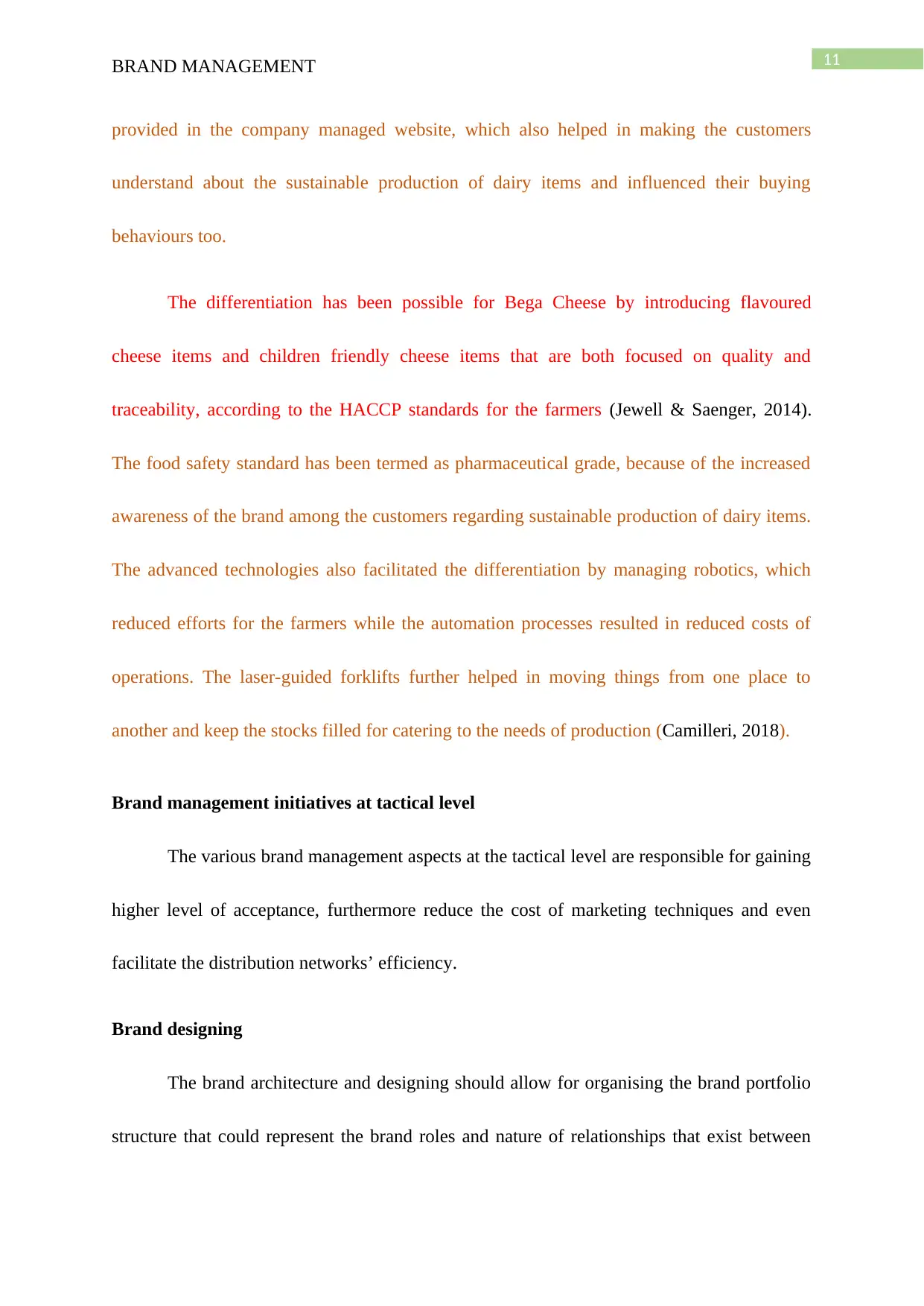
11BRAND MANAGEMENT
provided in the company managed website, which also helped in making the customers
understand about the sustainable production of dairy items and influenced their buying
behaviours too.
The differentiation has been possible for Bega Cheese by introducing flavoured
cheese items and children friendly cheese items that are both focused on quality and
traceability, according to the HACCP standards for the farmers (Jewell & Saenger, 2014).
The food safety standard has been termed as pharmaceutical grade, because of the increased
awareness of the brand among the customers regarding sustainable production of dairy items.
The advanced technologies also facilitated the differentiation by managing robotics, which
reduced efforts for the farmers while the automation processes resulted in reduced costs of
operations. The laser-guided forklifts further helped in moving things from one place to
another and keep the stocks filled for catering to the needs of production (Camilleri, 2018).
Brand management initiatives at tactical level
The various brand management aspects at the tactical level are responsible for gaining
higher level of acceptance, furthermore reduce the cost of marketing techniques and even
facilitate the distribution networks’ efficiency.
Brand designing
The brand architecture and designing should allow for organising the brand portfolio
structure that could represent the brand roles and nature of relationships that exist between
provided in the company managed website, which also helped in making the customers
understand about the sustainable production of dairy items and influenced their buying
behaviours too.
The differentiation has been possible for Bega Cheese by introducing flavoured
cheese items and children friendly cheese items that are both focused on quality and
traceability, according to the HACCP standards for the farmers (Jewell & Saenger, 2014).
The food safety standard has been termed as pharmaceutical grade, because of the increased
awareness of the brand among the customers regarding sustainable production of dairy items.
The advanced technologies also facilitated the differentiation by managing robotics, which
reduced efforts for the farmers while the automation processes resulted in reduced costs of
operations. The laser-guided forklifts further helped in moving things from one place to
another and keep the stocks filled for catering to the needs of production (Camilleri, 2018).
Brand management initiatives at tactical level
The various brand management aspects at the tactical level are responsible for gaining
higher level of acceptance, furthermore reduce the cost of marketing techniques and even
facilitate the distribution networks’ efficiency.
Brand designing
The brand architecture and designing should allow for organising the brand portfolio
structure that could represent the brand roles and nature of relationships that exist between
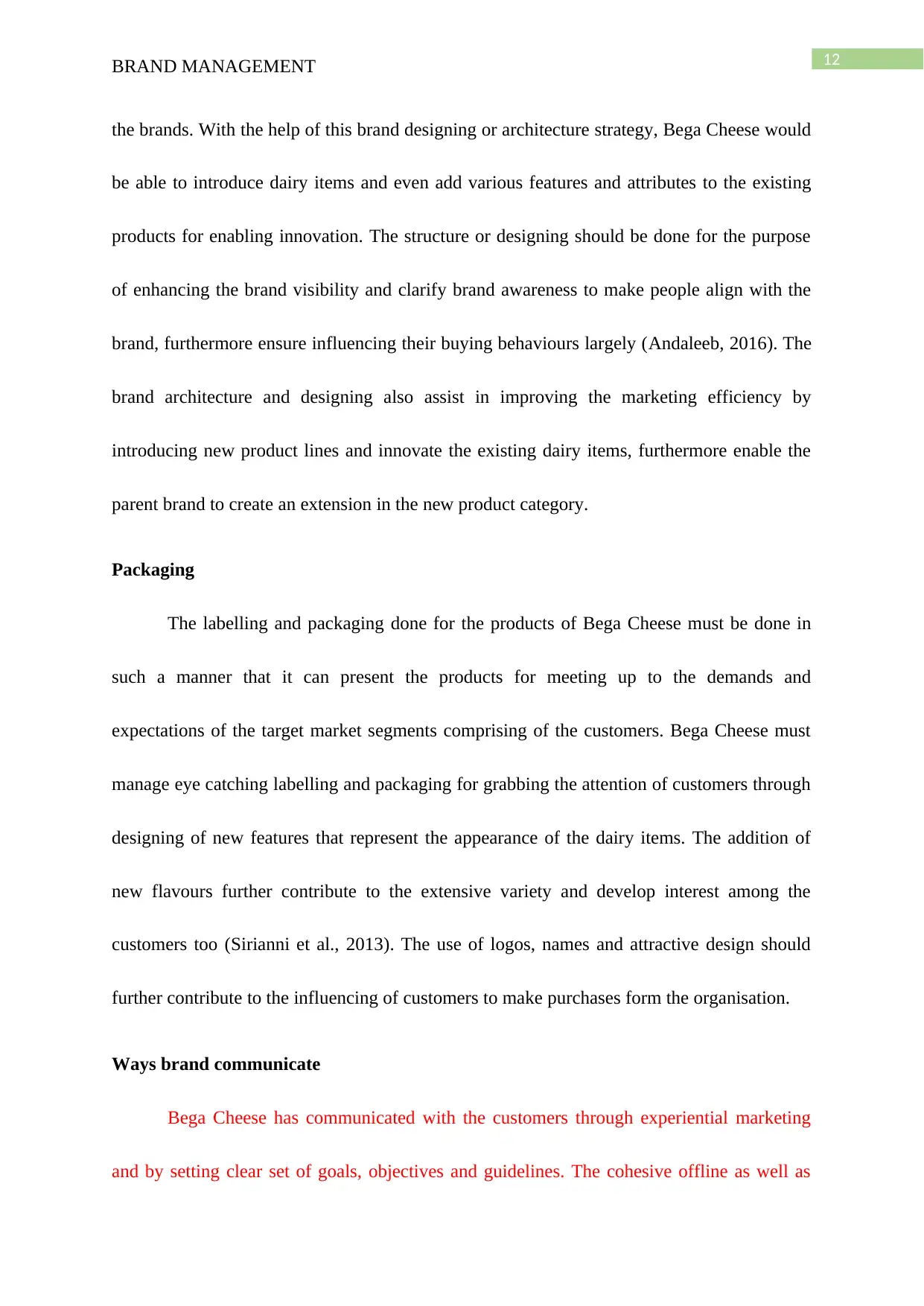
12BRAND MANAGEMENT
the brands. With the help of this brand designing or architecture strategy, Bega Cheese would
be able to introduce dairy items and even add various features and attributes to the existing
products for enabling innovation. The structure or designing should be done for the purpose
of enhancing the brand visibility and clarify brand awareness to make people align with the
brand, furthermore ensure influencing their buying behaviours largely (Andaleeb, 2016). The
brand architecture and designing also assist in improving the marketing efficiency by
introducing new product lines and innovate the existing dairy items, furthermore enable the
parent brand to create an extension in the new product category.
Packaging
The labelling and packaging done for the products of Bega Cheese must be done in
such a manner that it can present the products for meeting up to the demands and
expectations of the target market segments comprising of the customers. Bega Cheese must
manage eye catching labelling and packaging for grabbing the attention of customers through
designing of new features that represent the appearance of the dairy items. The addition of
new flavours further contribute to the extensive variety and develop interest among the
customers too (Sirianni et al., 2013). The use of logos, names and attractive design should
further contribute to the influencing of customers to make purchases form the organisation.
Ways brand communicate
Bega Cheese has communicated with the customers through experiential marketing
and by setting clear set of goals, objectives and guidelines. The cohesive offline as well as
the brands. With the help of this brand designing or architecture strategy, Bega Cheese would
be able to introduce dairy items and even add various features and attributes to the existing
products for enabling innovation. The structure or designing should be done for the purpose
of enhancing the brand visibility and clarify brand awareness to make people align with the
brand, furthermore ensure influencing their buying behaviours largely (Andaleeb, 2016). The
brand architecture and designing also assist in improving the marketing efficiency by
introducing new product lines and innovate the existing dairy items, furthermore enable the
parent brand to create an extension in the new product category.
Packaging
The labelling and packaging done for the products of Bega Cheese must be done in
such a manner that it can present the products for meeting up to the demands and
expectations of the target market segments comprising of the customers. Bega Cheese must
manage eye catching labelling and packaging for grabbing the attention of customers through
designing of new features that represent the appearance of the dairy items. The addition of
new flavours further contribute to the extensive variety and develop interest among the
customers too (Sirianni et al., 2013). The use of logos, names and attractive design should
further contribute to the influencing of customers to make purchases form the organisation.
Ways brand communicate
Bega Cheese has communicated with the customers through experiential marketing
and by setting clear set of goals, objectives and guidelines. The cohesive offline as well as
Paraphrase This Document
Need a fresh take? Get an instant paraphrase of this document with our AI Paraphraser
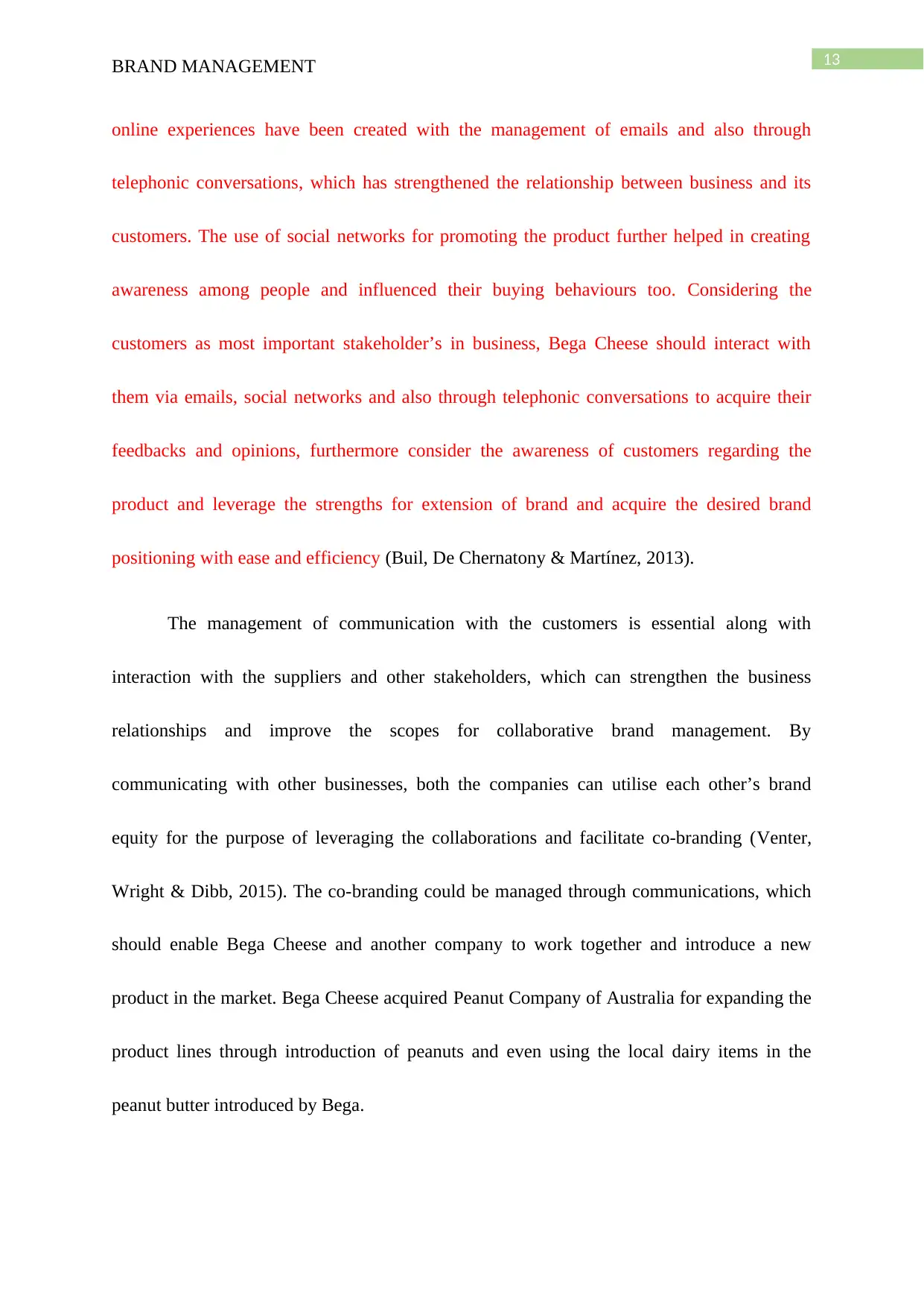
13BRAND MANAGEMENT
online experiences have been created with the management of emails and also through
telephonic conversations, which has strengthened the relationship between business and its
customers. The use of social networks for promoting the product further helped in creating
awareness among people and influenced their buying behaviours too. Considering the
customers as most important stakeholder’s in business, Bega Cheese should interact with
them via emails, social networks and also through telephonic conversations to acquire their
feedbacks and opinions, furthermore consider the awareness of customers regarding the
product and leverage the strengths for extension of brand and acquire the desired brand
positioning with ease and efficiency (Buil, De Chernatony & Martínez, 2013).
The management of communication with the customers is essential along with
interaction with the suppliers and other stakeholders, which can strengthen the business
relationships and improve the scopes for collaborative brand management. By
communicating with other businesses, both the companies can utilise each other’s brand
equity for the purpose of leveraging the collaborations and facilitate co-branding (Venter,
Wright & Dibb, 2015). The co-branding could be managed through communications, which
should enable Bega Cheese and another company to work together and introduce a new
product in the market. Bega Cheese acquired Peanut Company of Australia for expanding the
product lines through introduction of peanuts and even using the local dairy items in the
peanut butter introduced by Bega.
online experiences have been created with the management of emails and also through
telephonic conversations, which has strengthened the relationship between business and its
customers. The use of social networks for promoting the product further helped in creating
awareness among people and influenced their buying behaviours too. Considering the
customers as most important stakeholder’s in business, Bega Cheese should interact with
them via emails, social networks and also through telephonic conversations to acquire their
feedbacks and opinions, furthermore consider the awareness of customers regarding the
product and leverage the strengths for extension of brand and acquire the desired brand
positioning with ease and efficiency (Buil, De Chernatony & Martínez, 2013).
The management of communication with the customers is essential along with
interaction with the suppliers and other stakeholders, which can strengthen the business
relationships and improve the scopes for collaborative brand management. By
communicating with other businesses, both the companies can utilise each other’s brand
equity for the purpose of leveraging the collaborations and facilitate co-branding (Venter,
Wright & Dibb, 2015). The co-branding could be managed through communications, which
should enable Bega Cheese and another company to work together and introduce a new
product in the market. Bega Cheese acquired Peanut Company of Australia for expanding the
product lines through introduction of peanuts and even using the local dairy items in the
peanut butter introduced by Bega.
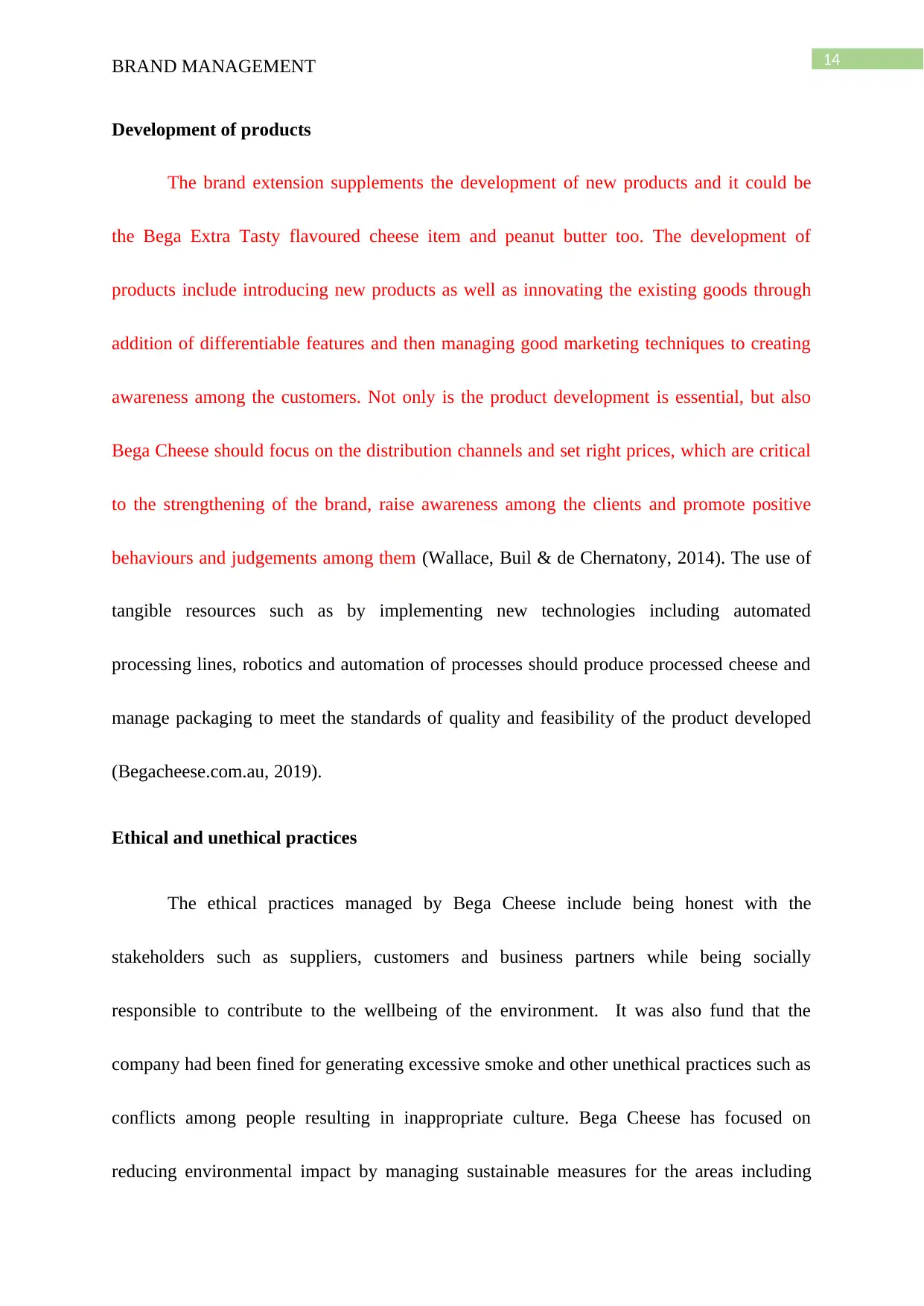
14BRAND MANAGEMENT
Development of products
The brand extension supplements the development of new products and it could be
the Bega Extra Tasty flavoured cheese item and peanut butter too. The development of
products include introducing new products as well as innovating the existing goods through
addition of differentiable features and then managing good marketing techniques to creating
awareness among the customers. Not only is the product development is essential, but also
Bega Cheese should focus on the distribution channels and set right prices, which are critical
to the strengthening of the brand, raise awareness among the clients and promote positive
behaviours and judgements among them (Wallace, Buil & de Chernatony, 2014). The use of
tangible resources such as by implementing new technologies including automated
processing lines, robotics and automation of processes should produce processed cheese and
manage packaging to meet the standards of quality and feasibility of the product developed
(Begacheese.com.au, 2019).
Ethical and unethical practices
The ethical practices managed by Bega Cheese include being honest with the
stakeholders such as suppliers, customers and business partners while being socially
responsible to contribute to the wellbeing of the environment. It was also fund that the
company had been fined for generating excessive smoke and other unethical practices such as
conflicts among people resulting in inappropriate culture. Bega Cheese has focused on
reducing environmental impact by managing sustainable measures for the areas including
Development of products
The brand extension supplements the development of new products and it could be
the Bega Extra Tasty flavoured cheese item and peanut butter too. The development of
products include introducing new products as well as innovating the existing goods through
addition of differentiable features and then managing good marketing techniques to creating
awareness among the customers. Not only is the product development is essential, but also
Bega Cheese should focus on the distribution channels and set right prices, which are critical
to the strengthening of the brand, raise awareness among the clients and promote positive
behaviours and judgements among them (Wallace, Buil & de Chernatony, 2014). The use of
tangible resources such as by implementing new technologies including automated
processing lines, robotics and automation of processes should produce processed cheese and
manage packaging to meet the standards of quality and feasibility of the product developed
(Begacheese.com.au, 2019).
Ethical and unethical practices
The ethical practices managed by Bega Cheese include being honest with the
stakeholders such as suppliers, customers and business partners while being socially
responsible to contribute to the wellbeing of the environment. It was also fund that the
company had been fined for generating excessive smoke and other unethical practices such as
conflicts among people resulting in inappropriate culture. Bega Cheese has focused on
reducing environmental impact by managing sustainable measures for the areas including
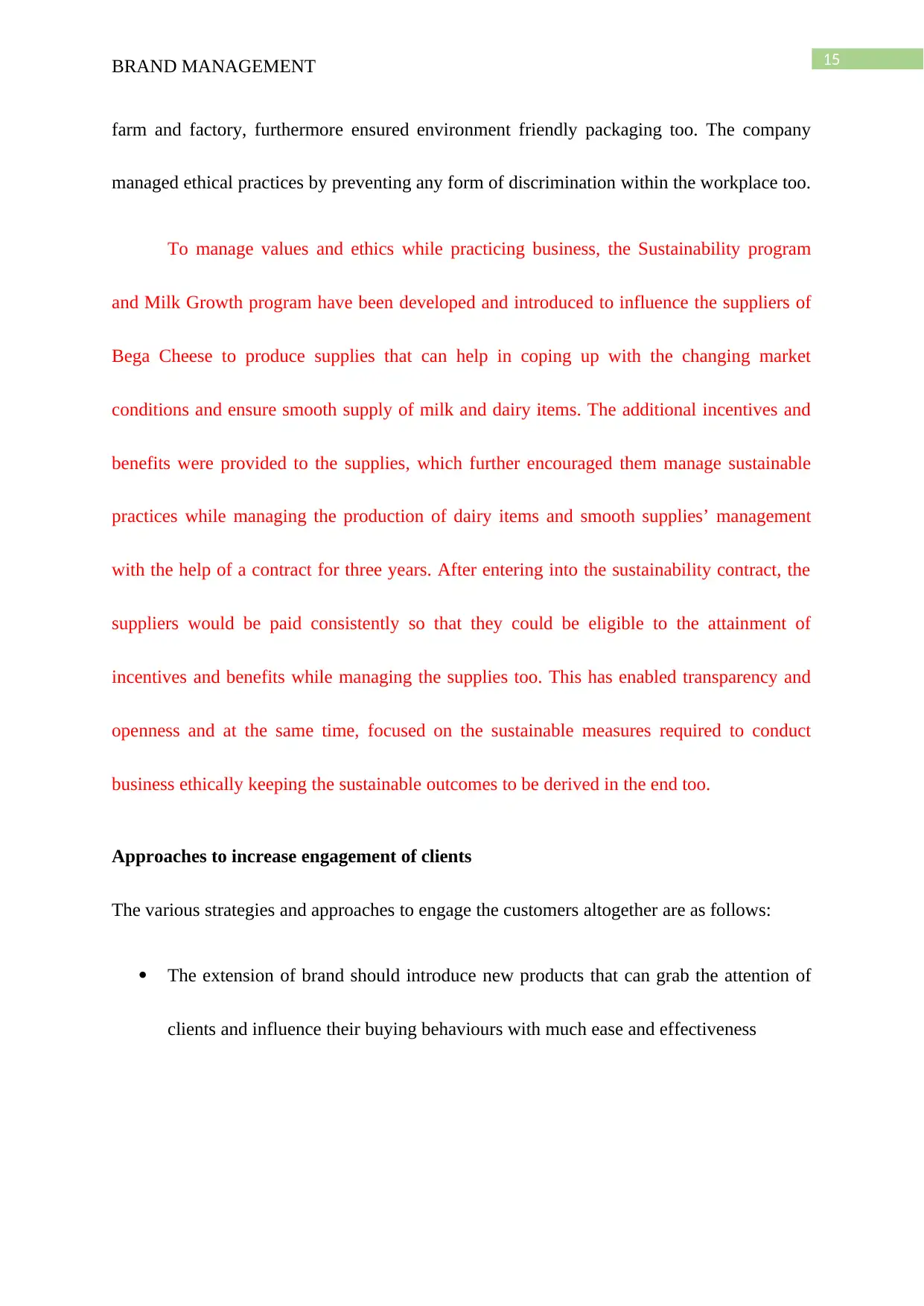
15BRAND MANAGEMENT
farm and factory, furthermore ensured environment friendly packaging too. The company
managed ethical practices by preventing any form of discrimination within the workplace too.
To manage values and ethics while practicing business, the Sustainability program
and Milk Growth program have been developed and introduced to influence the suppliers of
Bega Cheese to produce supplies that can help in coping up with the changing market
conditions and ensure smooth supply of milk and dairy items. The additional incentives and
benefits were provided to the supplies, which further encouraged them manage sustainable
practices while managing the production of dairy items and smooth supplies’ management
with the help of a contract for three years. After entering into the sustainability contract, the
suppliers would be paid consistently so that they could be eligible to the attainment of
incentives and benefits while managing the supplies too. This has enabled transparency and
openness and at the same time, focused on the sustainable measures required to conduct
business ethically keeping the sustainable outcomes to be derived in the end too.
Approaches to increase engagement of clients
The various strategies and approaches to engage the customers altogether are as follows:
The extension of brand should introduce new products that can grab the attention of
clients and influence their buying behaviours with much ease and effectiveness
farm and factory, furthermore ensured environment friendly packaging too. The company
managed ethical practices by preventing any form of discrimination within the workplace too.
To manage values and ethics while practicing business, the Sustainability program
and Milk Growth program have been developed and introduced to influence the suppliers of
Bega Cheese to produce supplies that can help in coping up with the changing market
conditions and ensure smooth supply of milk and dairy items. The additional incentives and
benefits were provided to the supplies, which further encouraged them manage sustainable
practices while managing the production of dairy items and smooth supplies’ management
with the help of a contract for three years. After entering into the sustainability contract, the
suppliers would be paid consistently so that they could be eligible to the attainment of
incentives and benefits while managing the supplies too. This has enabled transparency and
openness and at the same time, focused on the sustainable measures required to conduct
business ethically keeping the sustainable outcomes to be derived in the end too.
Approaches to increase engagement of clients
The various strategies and approaches to engage the customers altogether are as follows:
The extension of brand should introduce new products that can grab the attention of
clients and influence their buying behaviours with much ease and effectiveness
Secure Best Marks with AI Grader
Need help grading? Try our AI Grader for instant feedback on your assignments.
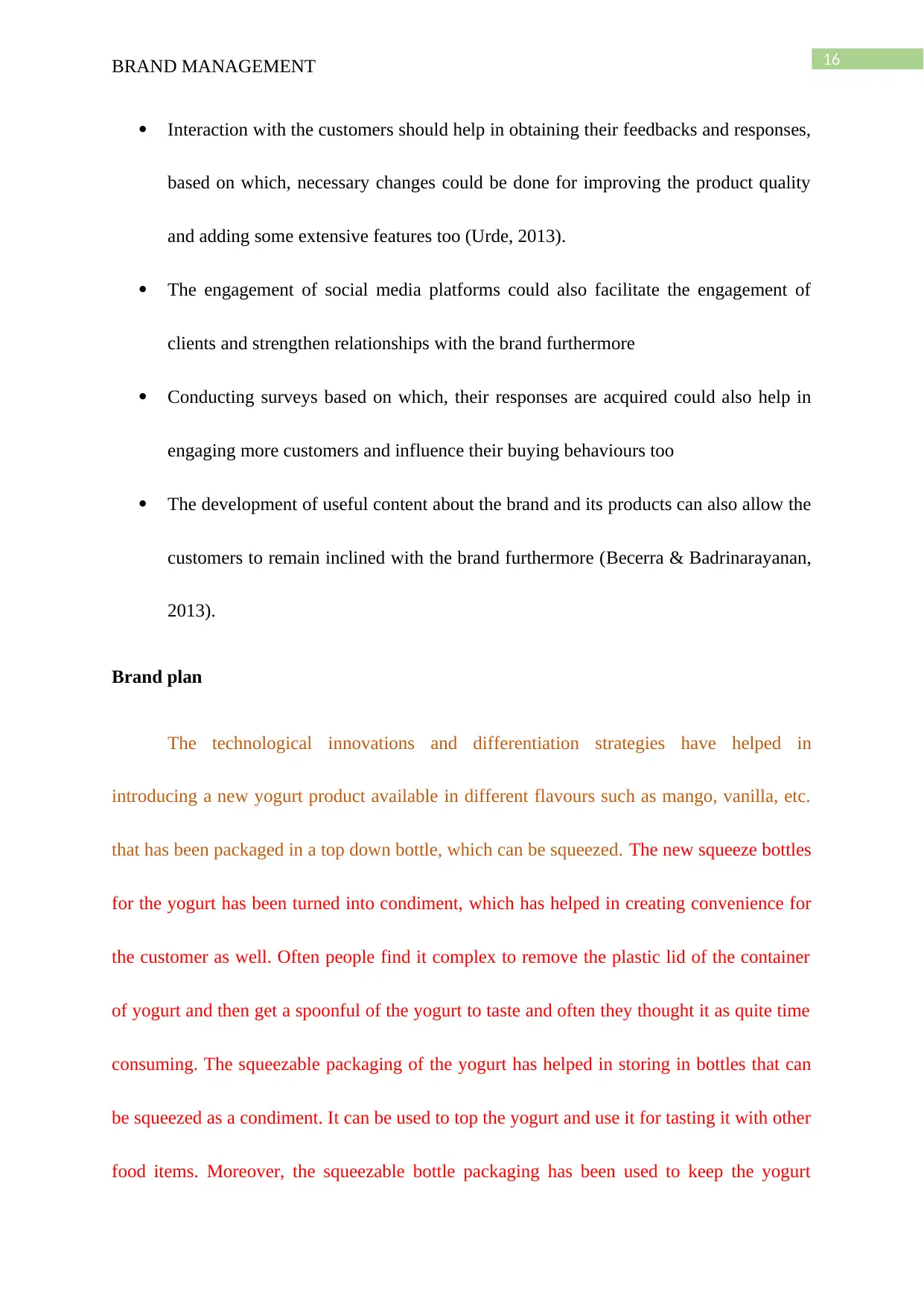
16BRAND MANAGEMENT
Interaction with the customers should help in obtaining their feedbacks and responses,
based on which, necessary changes could be done for improving the product quality
and adding some extensive features too (Urde, 2013).
The engagement of social media platforms could also facilitate the engagement of
clients and strengthen relationships with the brand furthermore
Conducting surveys based on which, their responses are acquired could also help in
engaging more customers and influence their buying behaviours too
The development of useful content about the brand and its products can also allow the
customers to remain inclined with the brand furthermore (Becerra & Badrinarayanan,
2013).
Brand plan
The technological innovations and differentiation strategies have helped in
introducing a new yogurt product available in different flavours such as mango, vanilla, etc.
that has been packaged in a top down bottle, which can be squeezed. The new squeeze bottles
for the yogurt has been turned into condiment, which has helped in creating convenience for
the customer as well. Often people find it complex to remove the plastic lid of the container
of yogurt and then get a spoonful of the yogurt to taste and often they thought it as quite time
consuming. The squeezable packaging of the yogurt has helped in storing in bottles that can
be squeezed as a condiment. It can be used to top the yogurt and use it for tasting it with other
food items. Moreover, the squeezable bottle packaging has been used to keep the yogurt
Interaction with the customers should help in obtaining their feedbacks and responses,
based on which, necessary changes could be done for improving the product quality
and adding some extensive features too (Urde, 2013).
The engagement of social media platforms could also facilitate the engagement of
clients and strengthen relationships with the brand furthermore
Conducting surveys based on which, their responses are acquired could also help in
engaging more customers and influence their buying behaviours too
The development of useful content about the brand and its products can also allow the
customers to remain inclined with the brand furthermore (Becerra & Badrinarayanan,
2013).
Brand plan
The technological innovations and differentiation strategies have helped in
introducing a new yogurt product available in different flavours such as mango, vanilla, etc.
that has been packaged in a top down bottle, which can be squeezed. The new squeeze bottles
for the yogurt has been turned into condiment, which has helped in creating convenience for
the customer as well. Often people find it complex to remove the plastic lid of the container
of yogurt and then get a spoonful of the yogurt to taste and often they thought it as quite time
consuming. The squeezable packaging of the yogurt has helped in storing in bottles that can
be squeezed as a condiment. It can be used to top the yogurt and use it for tasting it with other
food items. Moreover, the squeezable bottle packaging has been used to keep the yogurt
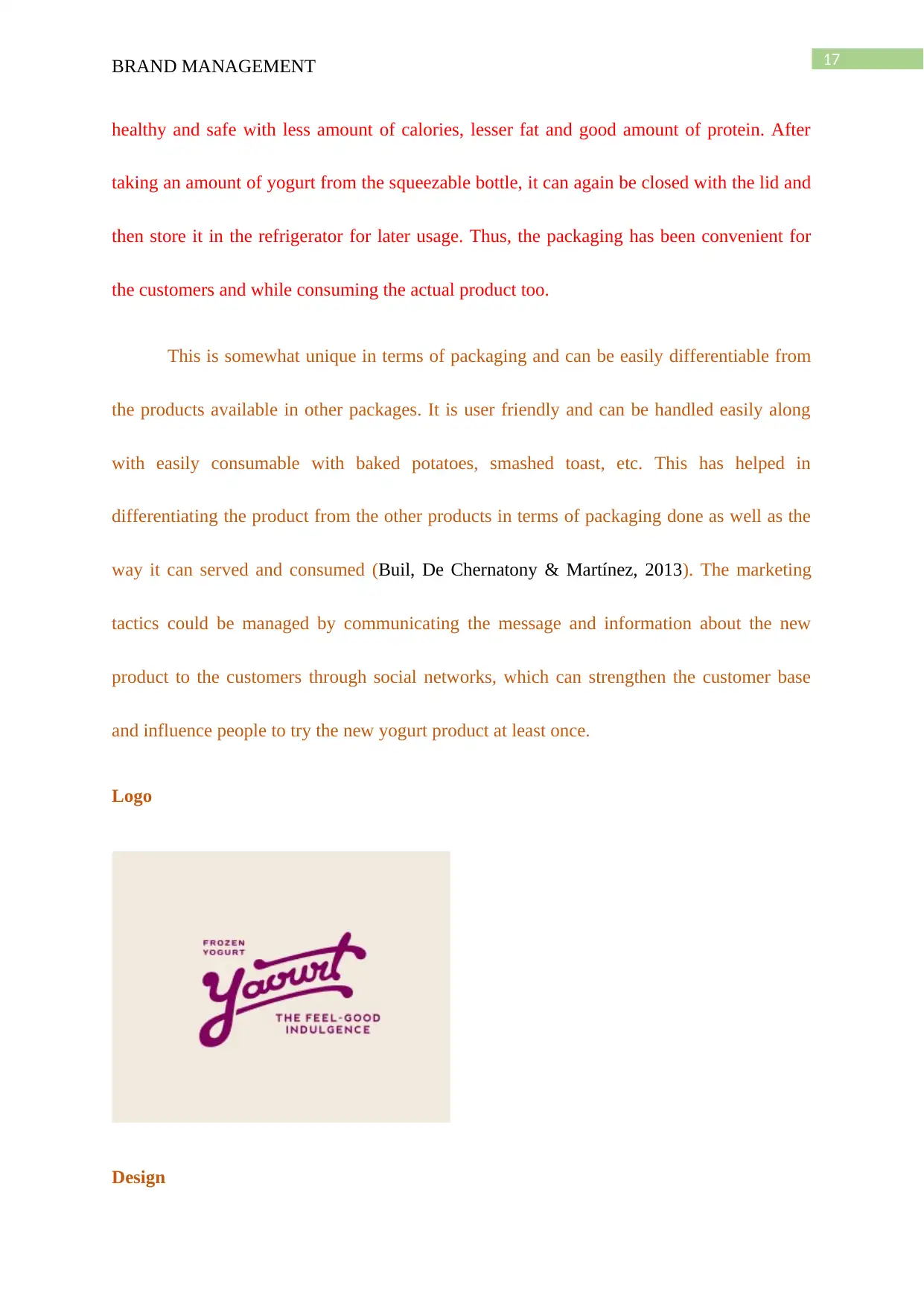
17BRAND MANAGEMENT
healthy and safe with less amount of calories, lesser fat and good amount of protein. After
taking an amount of yogurt from the squeezable bottle, it can again be closed with the lid and
then store it in the refrigerator for later usage. Thus, the packaging has been convenient for
the customers and while consuming the actual product too.
This is somewhat unique in terms of packaging and can be easily differentiable from
the products available in other packages. It is user friendly and can be handled easily along
with easily consumable with baked potatoes, smashed toast, etc. This has helped in
differentiating the product from the other products in terms of packaging done as well as the
way it can served and consumed (Buil, De Chernatony & Martínez, 2013). The marketing
tactics could be managed by communicating the message and information about the new
product to the customers through social networks, which can strengthen the customer base
and influence people to try the new yogurt product at least once.
Logo
Design
healthy and safe with less amount of calories, lesser fat and good amount of protein. After
taking an amount of yogurt from the squeezable bottle, it can again be closed with the lid and
then store it in the refrigerator for later usage. Thus, the packaging has been convenient for
the customers and while consuming the actual product too.
This is somewhat unique in terms of packaging and can be easily differentiable from
the products available in other packages. It is user friendly and can be handled easily along
with easily consumable with baked potatoes, smashed toast, etc. This has helped in
differentiating the product from the other products in terms of packaging done as well as the
way it can served and consumed (Buil, De Chernatony & Martínez, 2013). The marketing
tactics could be managed by communicating the message and information about the new
product to the customers through social networks, which can strengthen the customer base
and influence people to try the new yogurt product at least once.
Logo
Design
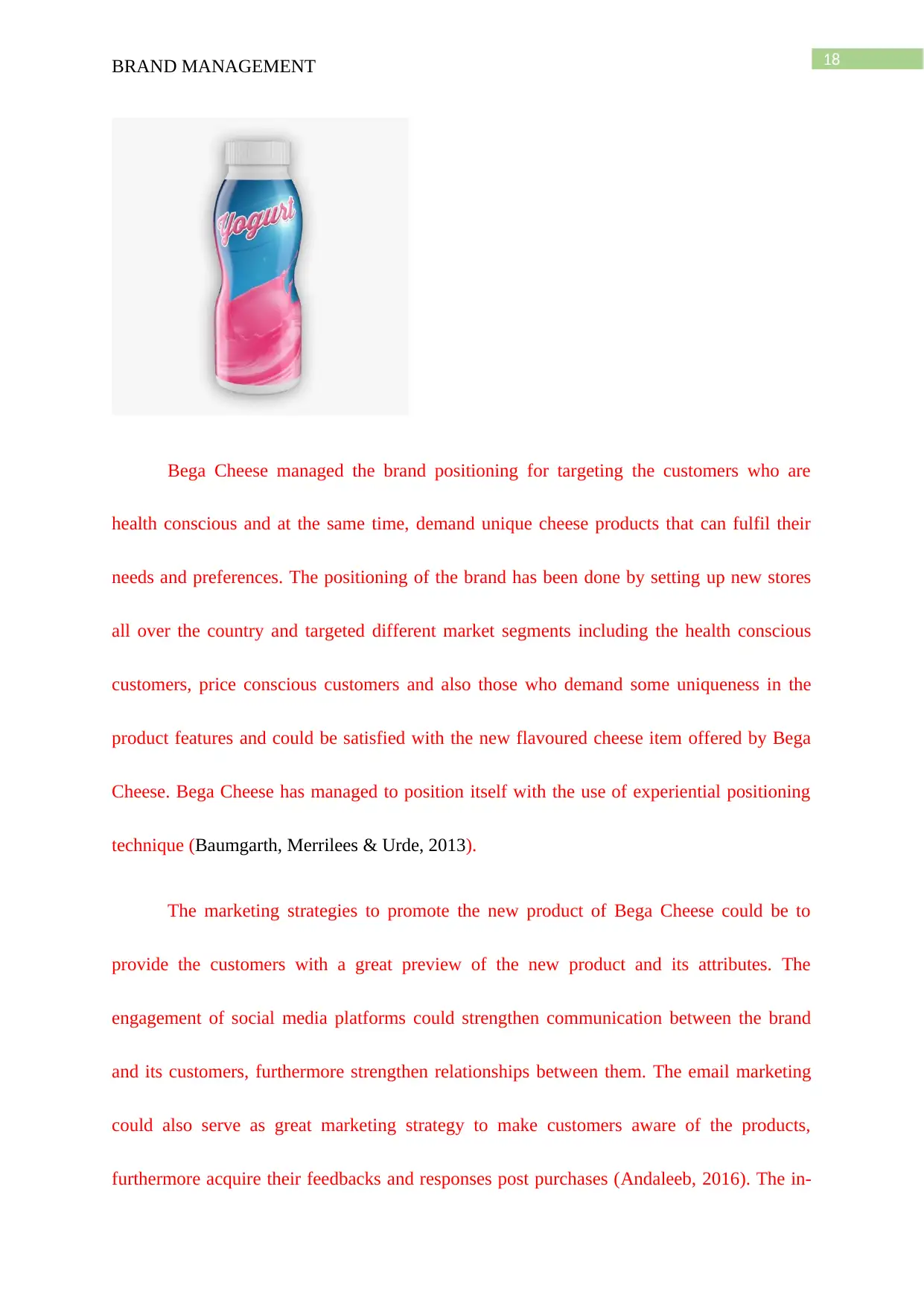
18BRAND MANAGEMENT
Bega Cheese managed the brand positioning for targeting the customers who are
health conscious and at the same time, demand unique cheese products that can fulfil their
needs and preferences. The positioning of the brand has been done by setting up new stores
all over the country and targeted different market segments including the health conscious
customers, price conscious customers and also those who demand some uniqueness in the
product features and could be satisfied with the new flavoured cheese item offered by Bega
Cheese. Bega Cheese has managed to position itself with the use of experiential positioning
technique (Baumgarth, Merrilees & Urde, 2013).
The marketing strategies to promote the new product of Bega Cheese could be to
provide the customers with a great preview of the new product and its attributes. The
engagement of social media platforms could strengthen communication between the brand
and its customers, furthermore strengthen relationships between them. The email marketing
could also serve as great marketing strategy to make customers aware of the products,
furthermore acquire their feedbacks and responses post purchases (Andaleeb, 2016). The in-
Bega Cheese managed the brand positioning for targeting the customers who are
health conscious and at the same time, demand unique cheese products that can fulfil their
needs and preferences. The positioning of the brand has been done by setting up new stores
all over the country and targeted different market segments including the health conscious
customers, price conscious customers and also those who demand some uniqueness in the
product features and could be satisfied with the new flavoured cheese item offered by Bega
Cheese. Bega Cheese has managed to position itself with the use of experiential positioning
technique (Baumgarth, Merrilees & Urde, 2013).
The marketing strategies to promote the new product of Bega Cheese could be to
provide the customers with a great preview of the new product and its attributes. The
engagement of social media platforms could strengthen communication between the brand
and its customers, furthermore strengthen relationships between them. The email marketing
could also serve as great marketing strategy to make customers aware of the products,
furthermore acquire their feedbacks and responses post purchases (Andaleeb, 2016). The in-
Paraphrase This Document
Need a fresh take? Get an instant paraphrase of this document with our AI Paraphraser
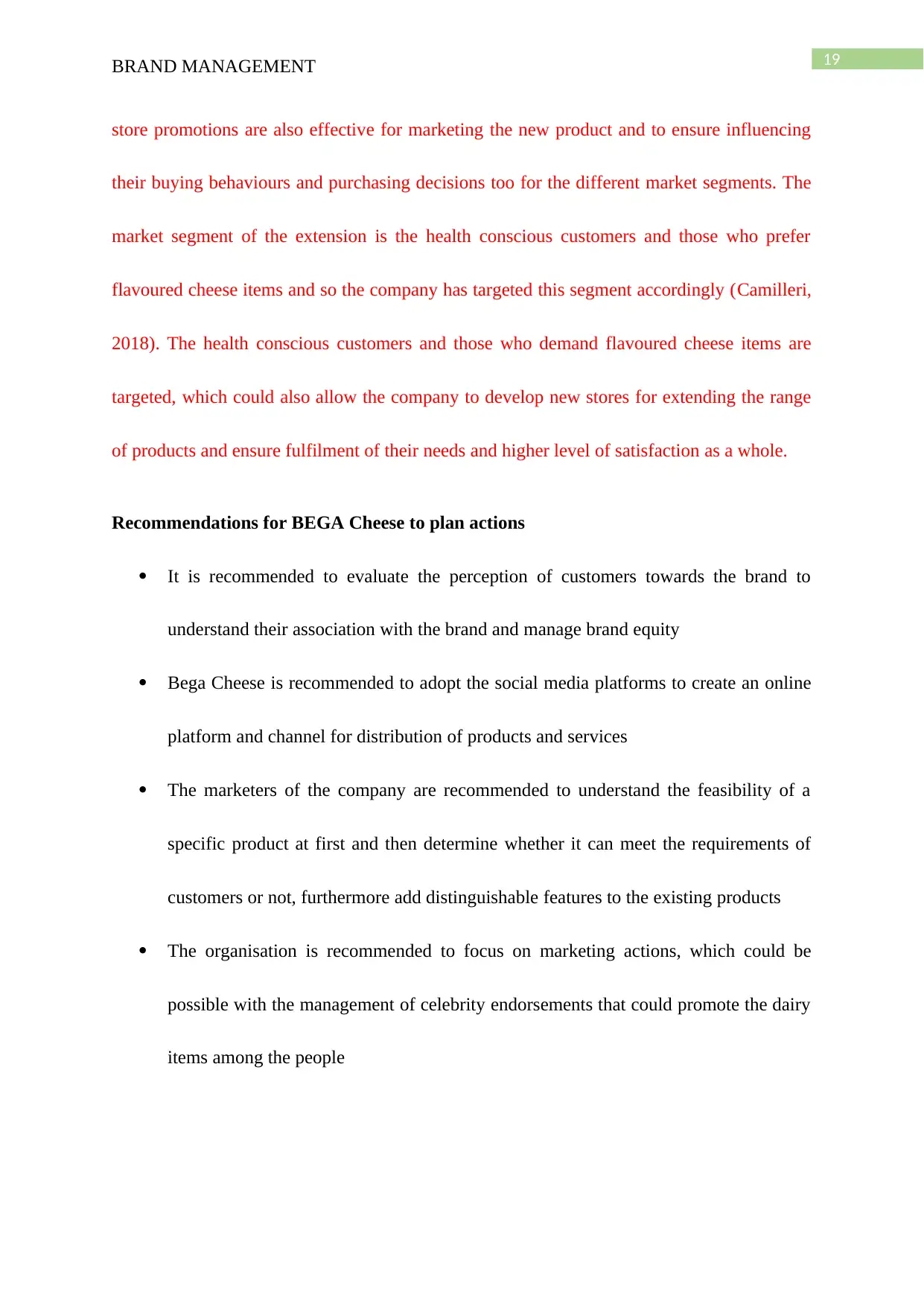
19BRAND MANAGEMENT
store promotions are also effective for marketing the new product and to ensure influencing
their buying behaviours and purchasing decisions too for the different market segments. The
market segment of the extension is the health conscious customers and those who prefer
flavoured cheese items and so the company has targeted this segment accordingly (Camilleri,
2018). The health conscious customers and those who demand flavoured cheese items are
targeted, which could also allow the company to develop new stores for extending the range
of products and ensure fulfilment of their needs and higher level of satisfaction as a whole.
Recommendations for BEGA Cheese to plan actions
It is recommended to evaluate the perception of customers towards the brand to
understand their association with the brand and manage brand equity
Bega Cheese is recommended to adopt the social media platforms to create an online
platform and channel for distribution of products and services
The marketers of the company are recommended to understand the feasibility of a
specific product at first and then determine whether it can meet the requirements of
customers or not, furthermore add distinguishable features to the existing products
The organisation is recommended to focus on marketing actions, which could be
possible with the management of celebrity endorsements that could promote the dairy
items among the people
store promotions are also effective for marketing the new product and to ensure influencing
their buying behaviours and purchasing decisions too for the different market segments. The
market segment of the extension is the health conscious customers and those who prefer
flavoured cheese items and so the company has targeted this segment accordingly (Camilleri,
2018). The health conscious customers and those who demand flavoured cheese items are
targeted, which could also allow the company to develop new stores for extending the range
of products and ensure fulfilment of their needs and higher level of satisfaction as a whole.
Recommendations for BEGA Cheese to plan actions
It is recommended to evaluate the perception of customers towards the brand to
understand their association with the brand and manage brand equity
Bega Cheese is recommended to adopt the social media platforms to create an online
platform and channel for distribution of products and services
The marketers of the company are recommended to understand the feasibility of a
specific product at first and then determine whether it can meet the requirements of
customers or not, furthermore add distinguishable features to the existing products
The organisation is recommended to focus on marketing actions, which could be
possible with the management of celebrity endorsements that could promote the dairy
items among the people
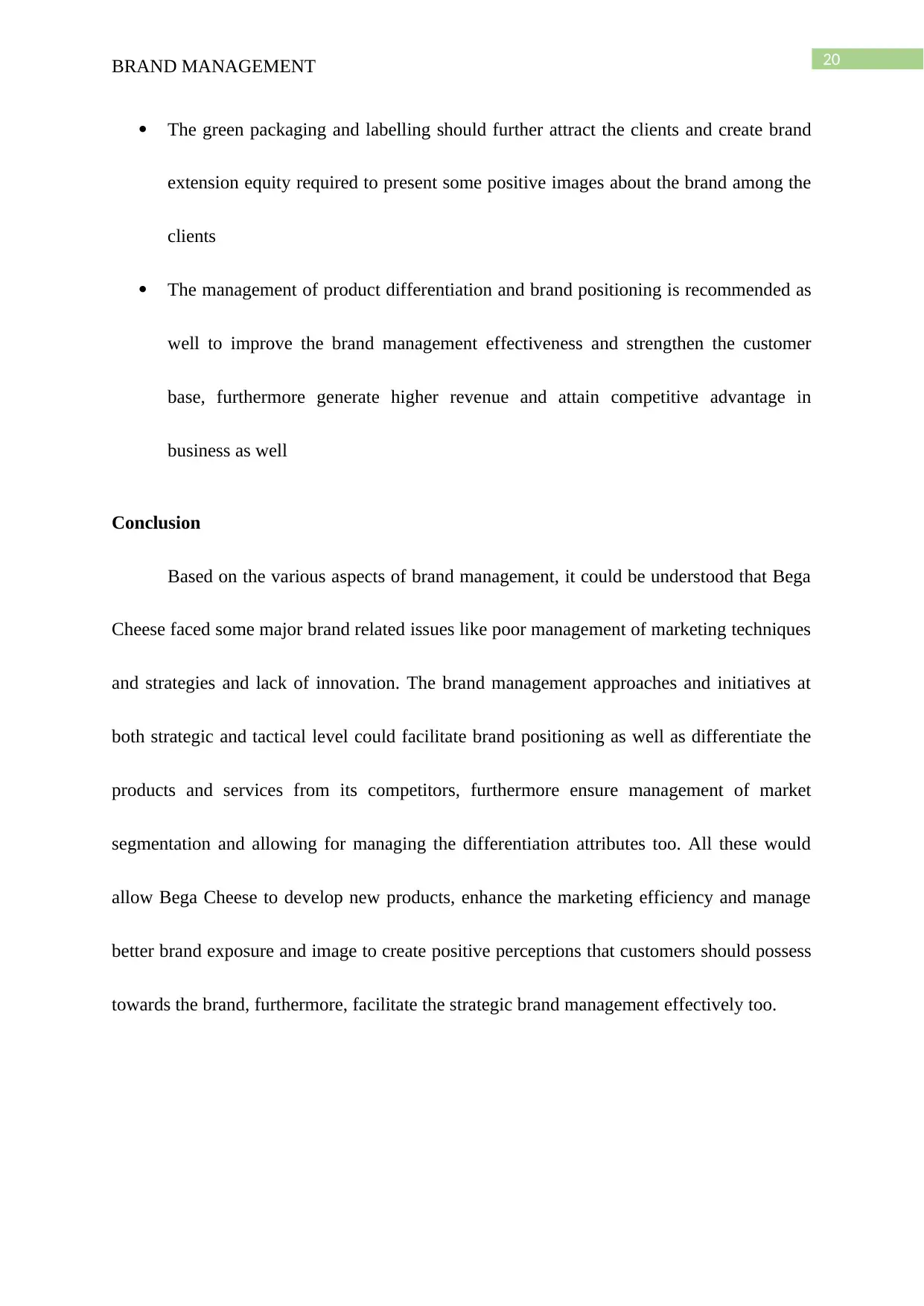
20BRAND MANAGEMENT
The green packaging and labelling should further attract the clients and create brand
extension equity required to present some positive images about the brand among the
clients
The management of product differentiation and brand positioning is recommended as
well to improve the brand management effectiveness and strengthen the customer
base, furthermore generate higher revenue and attain competitive advantage in
business as well
Conclusion
Based on the various aspects of brand management, it could be understood that Bega
Cheese faced some major brand related issues like poor management of marketing techniques
and strategies and lack of innovation. The brand management approaches and initiatives at
both strategic and tactical level could facilitate brand positioning as well as differentiate the
products and services from its competitors, furthermore ensure management of market
segmentation and allowing for managing the differentiation attributes too. All these would
allow Bega Cheese to develop new products, enhance the marketing efficiency and manage
better brand exposure and image to create positive perceptions that customers should possess
towards the brand, furthermore, facilitate the strategic brand management effectively too.
The green packaging and labelling should further attract the clients and create brand
extension equity required to present some positive images about the brand among the
clients
The management of product differentiation and brand positioning is recommended as
well to improve the brand management effectiveness and strengthen the customer
base, furthermore generate higher revenue and attain competitive advantage in
business as well
Conclusion
Based on the various aspects of brand management, it could be understood that Bega
Cheese faced some major brand related issues like poor management of marketing techniques
and strategies and lack of innovation. The brand management approaches and initiatives at
both strategic and tactical level could facilitate brand positioning as well as differentiate the
products and services from its competitors, furthermore ensure management of market
segmentation and allowing for managing the differentiation attributes too. All these would
allow Bega Cheese to develop new products, enhance the marketing efficiency and manage
better brand exposure and image to create positive perceptions that customers should possess
towards the brand, furthermore, facilitate the strategic brand management effectively too.
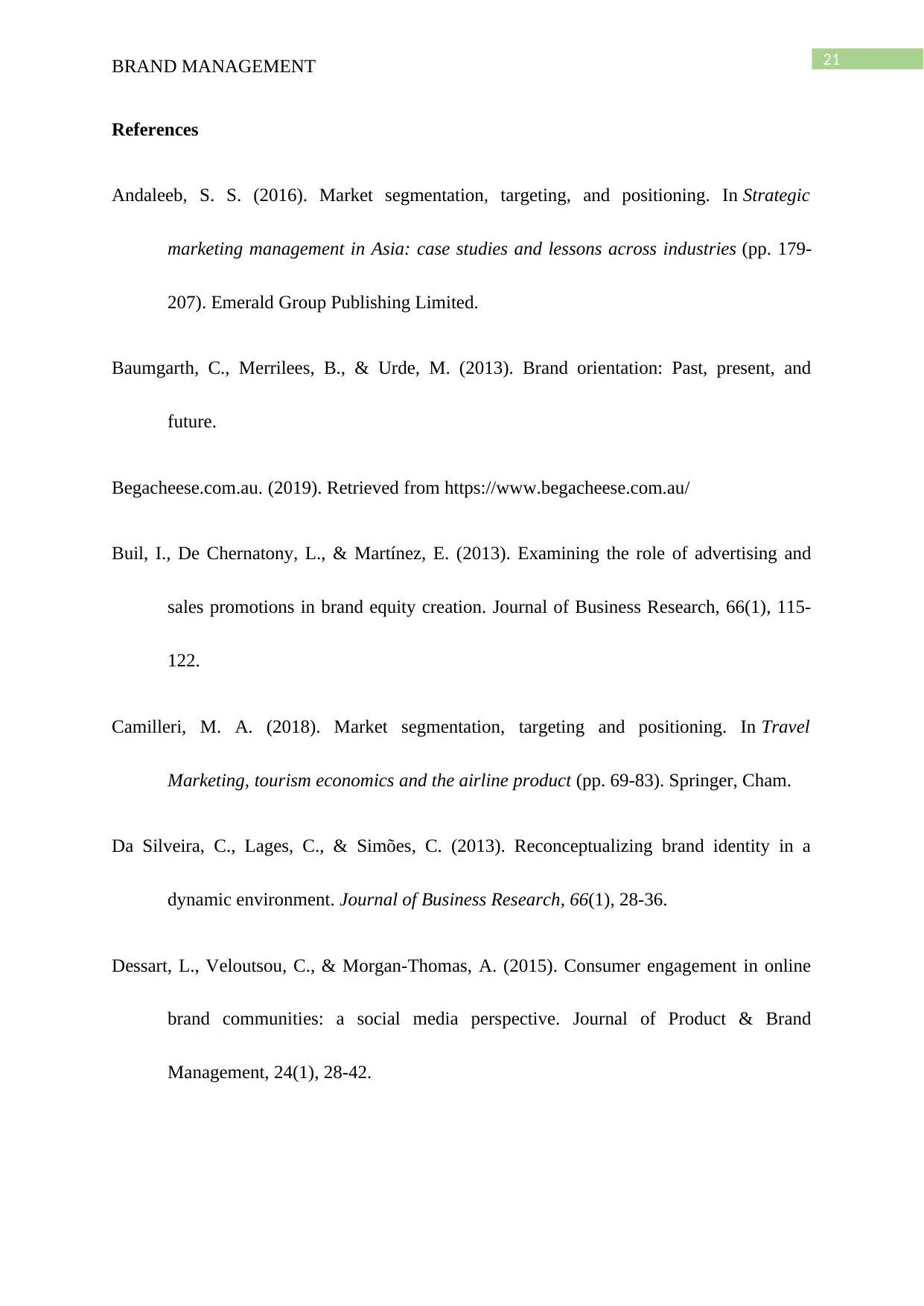
21BRAND MANAGEMENT
References
Andaleeb, S. S. (2016). Market segmentation, targeting, and positioning. In Strategic
marketing management in Asia: case studies and lessons across industries (pp. 179-
207). Emerald Group Publishing Limited.
Baumgarth, C., Merrilees, B., & Urde, M. (2013). Brand orientation: Past, present, and
future.
Begacheese.com.au. (2019). Retrieved from https://www.begacheese.com.au/
Buil, I., De Chernatony, L., & Martínez, E. (2013). Examining the role of advertising and
sales promotions in brand equity creation. Journal of Business Research, 66(1), 115-
122.
Camilleri, M. A. (2018). Market segmentation, targeting and positioning. In Travel
Marketing, tourism economics and the airline product (pp. 69-83). Springer, Cham.
Da Silveira, C., Lages, C., & Simões, C. (2013). Reconceptualizing brand identity in a
dynamic environment. Journal of Business Research, 66(1), 28-36.
Dessart, L., Veloutsou, C., & Morgan-Thomas, A. (2015). Consumer engagement in online
brand communities: a social media perspective. Journal of Product & Brand
Management, 24(1), 28-42.
References
Andaleeb, S. S. (2016). Market segmentation, targeting, and positioning. In Strategic
marketing management in Asia: case studies and lessons across industries (pp. 179-
207). Emerald Group Publishing Limited.
Baumgarth, C., Merrilees, B., & Urde, M. (2013). Brand orientation: Past, present, and
future.
Begacheese.com.au. (2019). Retrieved from https://www.begacheese.com.au/
Buil, I., De Chernatony, L., & Martínez, E. (2013). Examining the role of advertising and
sales promotions in brand equity creation. Journal of Business Research, 66(1), 115-
122.
Camilleri, M. A. (2018). Market segmentation, targeting and positioning. In Travel
Marketing, tourism economics and the airline product (pp. 69-83). Springer, Cham.
Da Silveira, C., Lages, C., & Simões, C. (2013). Reconceptualizing brand identity in a
dynamic environment. Journal of Business Research, 66(1), 28-36.
Dessart, L., Veloutsou, C., & Morgan-Thomas, A. (2015). Consumer engagement in online
brand communities: a social media perspective. Journal of Product & Brand
Management, 24(1), 28-42.
Secure Best Marks with AI Grader
Need help grading? Try our AI Grader for instant feedback on your assignments.
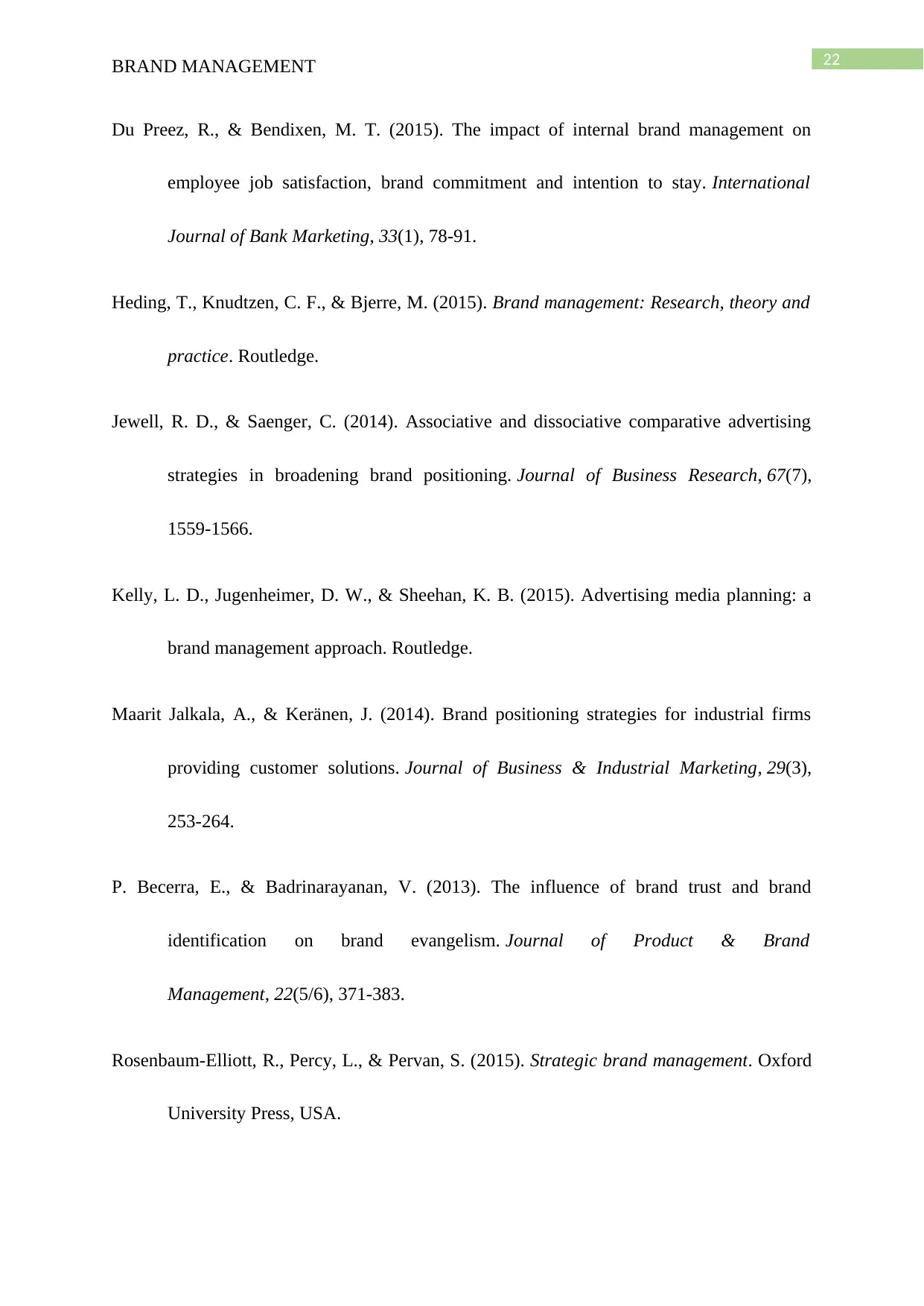
22BRAND MANAGEMENT
Du Preez, R., & Bendixen, M. T. (2015). The impact of internal brand management on
employee job satisfaction, brand commitment and intention to stay. International
Journal of Bank Marketing, 33(1), 78-91.
Heding, T., Knudtzen, C. F., & Bjerre, M. (2015). Brand management: Research, theory and
practice. Routledge.
Jewell, R. D., & Saenger, C. (2014). Associative and dissociative comparative advertising
strategies in broadening brand positioning. Journal of Business Research, 67(7),
1559-1566.
Kelly, L. D., Jugenheimer, D. W., & Sheehan, K. B. (2015). Advertising media planning: a
brand management approach. Routledge.
Maarit Jalkala, A., & Keränen, J. (2014). Brand positioning strategies for industrial firms
providing customer solutions. Journal of Business & Industrial Marketing, 29(3),
253-264.
P. Becerra, E., & Badrinarayanan, V. (2013). The influence of brand trust and brand
identification on brand evangelism. Journal of Product & Brand
Management, 22(5/6), 371-383.
Rosenbaum-Elliott, R., Percy, L., & Pervan, S. (2015). Strategic brand management. Oxford
University Press, USA.
Du Preez, R., & Bendixen, M. T. (2015). The impact of internal brand management on
employee job satisfaction, brand commitment and intention to stay. International
Journal of Bank Marketing, 33(1), 78-91.
Heding, T., Knudtzen, C. F., & Bjerre, M. (2015). Brand management: Research, theory and
practice. Routledge.
Jewell, R. D., & Saenger, C. (2014). Associative and dissociative comparative advertising
strategies in broadening brand positioning. Journal of Business Research, 67(7),
1559-1566.
Kelly, L. D., Jugenheimer, D. W., & Sheehan, K. B. (2015). Advertising media planning: a
brand management approach. Routledge.
Maarit Jalkala, A., & Keränen, J. (2014). Brand positioning strategies for industrial firms
providing customer solutions. Journal of Business & Industrial Marketing, 29(3),
253-264.
P. Becerra, E., & Badrinarayanan, V. (2013). The influence of brand trust and brand
identification on brand evangelism. Journal of Product & Brand
Management, 22(5/6), 371-383.
Rosenbaum-Elliott, R., Percy, L., & Pervan, S. (2015). Strategic brand management. Oxford
University Press, USA.
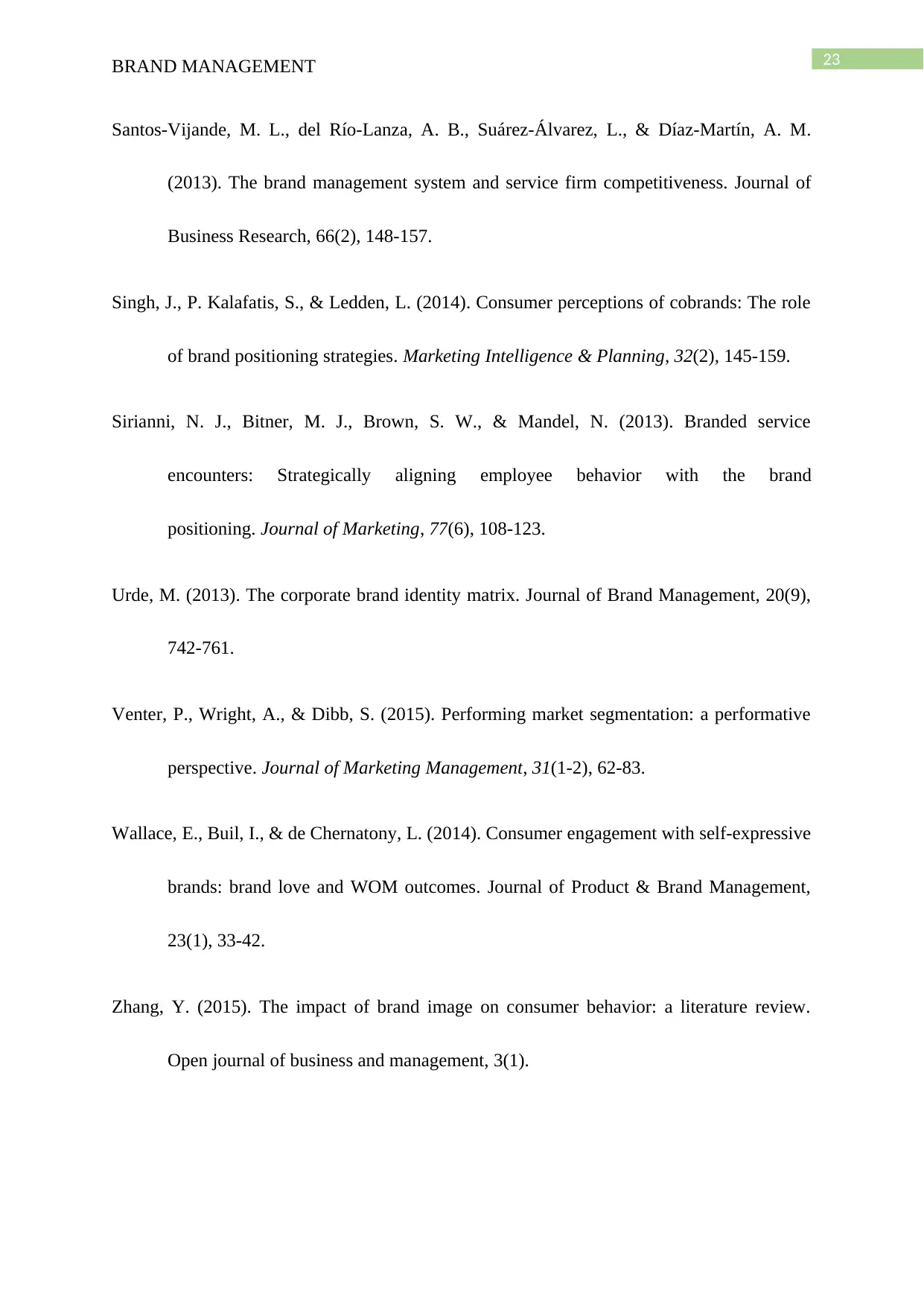
23BRAND MANAGEMENT
Santos-Vijande, M. L., del Río-Lanza, A. B., Suárez-Álvarez, L., & Díaz-Martín, A. M.
(2013). The brand management system and service firm competitiveness. Journal of
Business Research, 66(2), 148-157.
Singh, J., P. Kalafatis, S., & Ledden, L. (2014). Consumer perceptions of cobrands: The role
of brand positioning strategies. Marketing Intelligence & Planning, 32(2), 145-159.
Sirianni, N. J., Bitner, M. J., Brown, S. W., & Mandel, N. (2013). Branded service
encounters: Strategically aligning employee behavior with the brand
positioning. Journal of Marketing, 77(6), 108-123.
Urde, M. (2013). The corporate brand identity matrix. Journal of Brand Management, 20(9),
742-761.
Venter, P., Wright, A., & Dibb, S. (2015). Performing market segmentation: a performative
perspective. Journal of Marketing Management, 31(1-2), 62-83.
Wallace, E., Buil, I., & de Chernatony, L. (2014). Consumer engagement with self-expressive
brands: brand love and WOM outcomes. Journal of Product & Brand Management,
23(1), 33-42.
Zhang, Y. (2015). The impact of brand image on consumer behavior: a literature review.
Open journal of business and management, 3(1).
Santos-Vijande, M. L., del Río-Lanza, A. B., Suárez-Álvarez, L., & Díaz-Martín, A. M.
(2013). The brand management system and service firm competitiveness. Journal of
Business Research, 66(2), 148-157.
Singh, J., P. Kalafatis, S., & Ledden, L. (2014). Consumer perceptions of cobrands: The role
of brand positioning strategies. Marketing Intelligence & Planning, 32(2), 145-159.
Sirianni, N. J., Bitner, M. J., Brown, S. W., & Mandel, N. (2013). Branded service
encounters: Strategically aligning employee behavior with the brand
positioning. Journal of Marketing, 77(6), 108-123.
Urde, M. (2013). The corporate brand identity matrix. Journal of Brand Management, 20(9),
742-761.
Venter, P., Wright, A., & Dibb, S. (2015). Performing market segmentation: a performative
perspective. Journal of Marketing Management, 31(1-2), 62-83.
Wallace, E., Buil, I., & de Chernatony, L. (2014). Consumer engagement with self-expressive
brands: brand love and WOM outcomes. Journal of Product & Brand Management,
23(1), 33-42.
Zhang, Y. (2015). The impact of brand image on consumer behavior: a literature review.
Open journal of business and management, 3(1).
1 out of 24
Related Documents
Your All-in-One AI-Powered Toolkit for Academic Success.
+13062052269
info@desklib.com
Available 24*7 on WhatsApp / Email
![[object Object]](/_next/static/media/star-bottom.7253800d.svg)
Unlock your academic potential
© 2024 | Zucol Services PVT LTD | All rights reserved.





